GENERAL ELECTRIC PFSS6SMXSS, PFSS6SKXSS, PFSF6PKXWW, PFSF6PKXBB, GFSS6KIXSS User Manual
...
Refrigerators
Bottom Freezer
ge.com
Safety Instructions . . . . . . . . . . .2, 3
Operating Instructions
Automatic Icemaker . . . . . . . . . . . . . . .11
Care and Cleaning . . . . . . . . . . . . .12, 13
Controls . . . . . . . . . . . . . . . . . . . . . . . . . . . .4
Dispenser . . . . . . . . . . . . . . . . . . . . . . . . . . .5
Freezer . . . . . . . . . . . . . . . . . . . . . . . . . . . .10
Replacing the Light Bulbs . . . . . . . . . .14
Fresh Food Storage Options . . . . . . .7–9
Water Filter . . . . . . . . . . . . . . . . . . . . . . . . .6
Installation Instructions
Installing the Refrigerator . . . . . . .16–23 Installing the Water Line . . . . . . . .24–26 Preparing to Install
the Refrigerator . . . . . . . . . . . . . . . . . . . .15
Troubleshooting Tips . . . . . .27–30
Normal Operating Sounds . . . . . . . . . .27
Consumer Support
Consumer Support . . . . . . . .Back Cover Performance Data Sheet . . . . . . . . . . .39 Product Registration
for Canadian Customers . . . . . . . .35, 36 Product Registration
for U.S. Customers . . . . . . . . . . . . .33, 34 State of California Water
Treatment Device Certificate . . . . . . .40 Warranty for Canadian
Customers . . . . . . . . . . . . . . . . . . . . . . . . .38 Warranty for U.S. Customers . . . . . . .37
Write the model and serial numbers here:
Model # ____________________
Serial # ____________________
Find these numbers on a label on the left side, near the middle of the refrigerator compartment.
Owner’s Manual and
Installation Instructions
GE Model 26
Congélateur inférieur
Réfrigérateurs
Manuel d’utilisation et d’installation
La section française commence à la page 41
Congelador inferior
Refrigeradores
Manual del propietario y instalación
La sección en español empieza en la página 75
197D7926P001 49-60551-1 02-08 JR
Downloaded from www.Manualslib.com manuals search engine
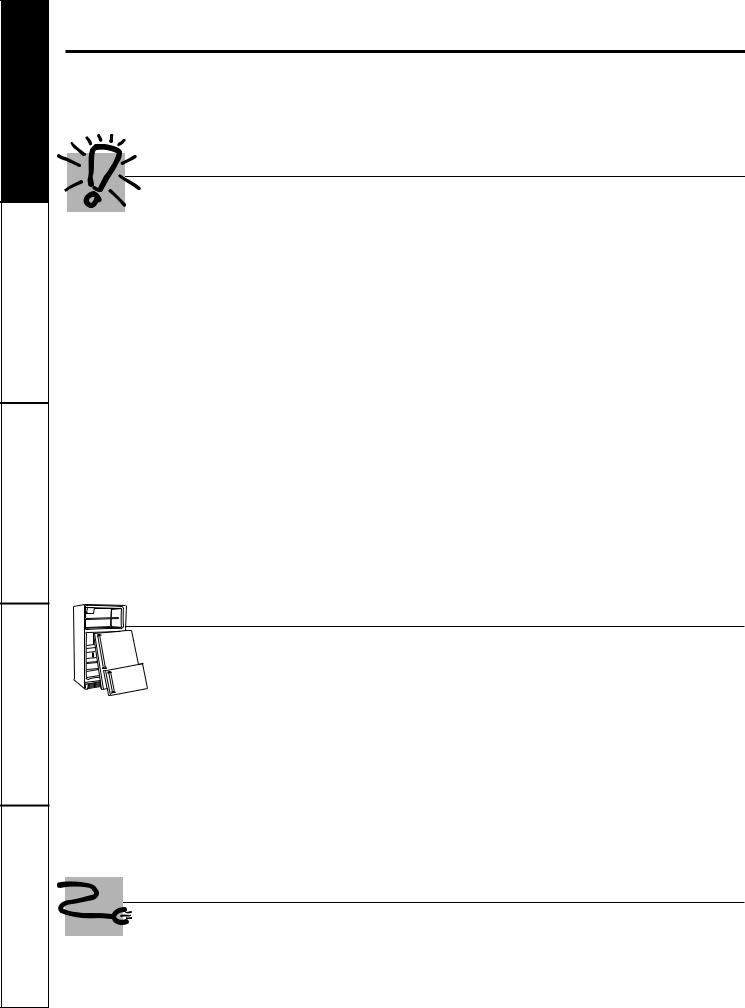
Operating Instructions Safety Instructions
Installation |
Instructions |
Consumer Support Troubleshooting Tips
IMPORTANT SAFETY INFORMATION.
READ ALL INSTRUCTIONS BEFORE USING.
 WARNING!
WARNING!
Use this appliance only for its intended purpose as described in this Owner’s Manual.
SAFETY PRECAUTIONS
When using electrical appliances, basic safety precautions should be followed, including the following:
■This refrigerator must be properly installed and located in accordance with the Installation Instructions before it is used.
■Do not allow children to climb, stand or hang on the shelves in the refrigerator. They could damage the refrigerator and seriously injure themselves.
■Do not touch the cold surfaces in the freezer compartment when hands are damp or wet. Skin may stick to these extremely cold surfaces.
■Do not store or use gasoline or other flammable vapors and liquids in the vicinity of this or any other appliance.
■Keep fingers out of the “pinch point” areas; clearances between the doors and between the doors and cabinet are necessarily small. Be careful closing doors when children are in the area.
■In refrigerators with automatic icemakers, avoid contact with the moving parts of the ejector mechanism, or with the heating element that releases the cubes. Do not place fingers or hands on the automatic icemaking mechanism while the refrigerator is plugged in.
■Unplug the refrigerator before cleaning and making repairs.
NOTE: We strongly recommend that any servicing be performed by a qualified individual.
■Do not refreeze frozen foods which have thawed completely.
 DANGER! RISK OF CHILD ENTRAPMENT
DANGER! RISK OF CHILD ENTRAPMENT
PROPER DISPOSAL OF THE REFRIGERATOR
Child entrapment and suffocation are not problems |
Refrigerants |
|
of the past. Junked or abandoned refrigerators are |
All refrigeration products contain refrigerants, |
|
still dangerous…even if they will sit for “just a few |
||
which under federal law must be removed prior |
||
days.” If you are getting rid of your old refrigerator, |
||
to product disposal. If you are getting rid of an old |
||
please follow the instructions below to help prevent |
||
refrigeration product, check with the company |
||
accidents. |
||
handling the disposal about what to do. |
||
Before You Throw Away Your Old |
||
|
||
Refrigerator or Freezer: |
|
■Take off the doors.
■Leave the shelves in place so that children may not easily climb inside.
USE OF EXTENSION CORDS
Because of potential safety hazards under certain conditions, we strongly recommend against the use of an extension cord.
However, if you must use an extension cord, it is absolutely necessary that it be a UL-listed (in the United States) or a CSA certified (in Canada), 3-wire grounding type appliance extension cord having a grounding type plug
2and outlet and that the electrical rating of the cord be 15 amperes (minimum) and 120 volts.
Downloaded from www.Manualslib.com manuals search engine
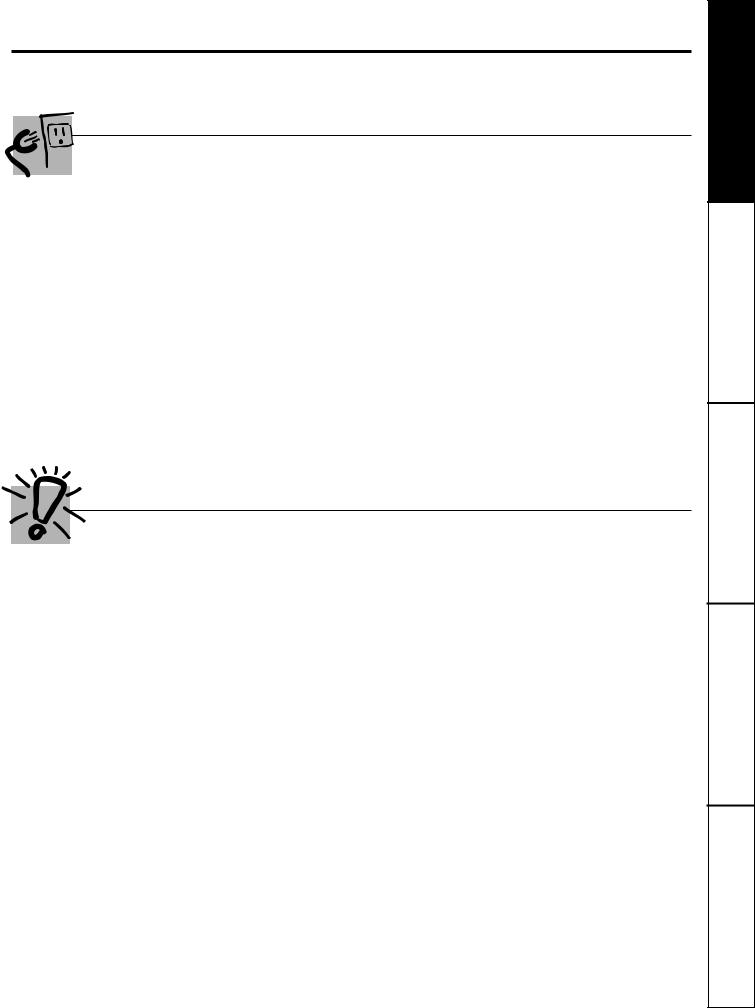
ge.com
 WARNING!
WARNING!
HOW TO CONNECT ELECTRICITY
Do not, under any circumstances, cut or remove the third (ground) prong from the power cord. For personal safety, this appliance must be properly grounded.
The power cord of this appliance is equipped with a 3-prong (grounding) plug which mates with a standard 3-prong (grounding) wall outlet to minimize the possibility of electric shock hazard from this appliance.
Have the wall outlet and circuit checked by a qualified electrician to make sure the outlet is properly grounded.
Where a standard 2-prong wall outlet is encountered, it is your personal responsibility and obligation to have it replaced with a properly grounded 3-prong wall outlet.
The refrigerator should always be plugged into its own individual electrical outlet which has a voltage rating that matches the rating plate.
This provides the best performance and also prevents overloading house wiring circuits which could cause a fire hazard from overheated wires.
Never unplug your refrigerator by pulling on the power cord. Always grip plug firmly and pull straight out from the outlet.
Repair or replace immediately all power cords that have become frayed or otherwise damaged. Do not use a cord that shows cracks or abrasion damage along its length or at either end.
When moving the refrigerator away from the wall, be careful not to roll over or damage the power cord.
READ AND FOLLOW THIS SAFETY INFORMATION CAREFULLY.
SAVE THESE INSTRUCTIONS
3
Instructions Operating Instructions Safety
Instructions |
Installation |
Support Consumer Tips Troubleshooting
Downloaded from www.Manualslib.com manuals search engine
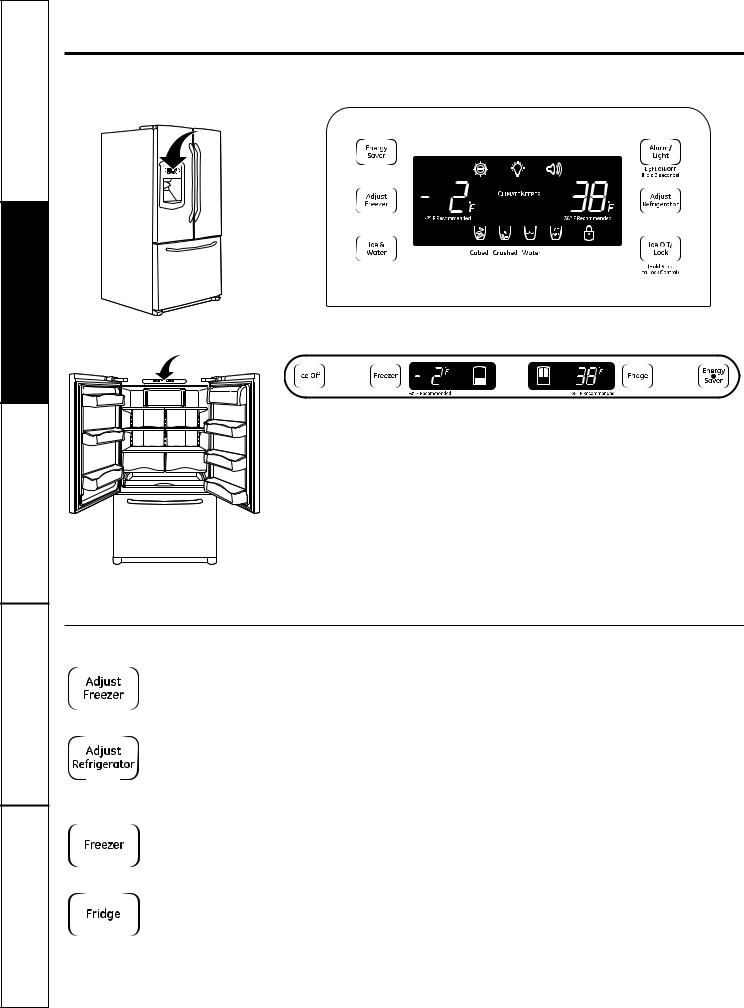
Operating Instructions Safety Instructions
Installation |
Instructions |
Consumer Support Troubleshooting Tips
About the controls with temperature settings.
Not all features are on all models. Your controls will look like one of the following:
Location of Dispenser Controls
Location of Internal Controls
Dispenser Models
Internal Control Models
NOTE: The refrigerator is shipped with protective film covering the temperature controls. If this film was not removed during installation, remove it now.
The temperature controls are preset in the factory at 38°F for the refrigerator compartment and -2°F for the freezer compartment. Allow 24 hours for
the temperature to stabilize to the preset recommended settings.
The temperature controls can display both the SET temperature as well as the actual temperature in the refrigerator and freezer. The actual temperature may vary slightly from the SET temperature based on usage and operating environment.
Changing the Temperature
Dispenser models:
To change the temperature, press and release the Adjust Freezer or Adjust Refrigerator pad. The display will show the actual temperature.
Tap either the Adjust Freezer or Adjust Refrigerator pad until the desired temperature is displayed.
Internal control models:
To change the temperature, press and release the Freezer or Fridge pad. The display will show the actual temperature. Tap either the Freezer or
Fridge pad until the desired temperature is displayed.
Once the desired temperature has been set, the temperature display will return to the actual refrigerator and freezer temperatures after
10 seconds. Several adjustments may be required.
Each time you adjust controls, allow 24 hours for the refrigerator to reach the temperature you have set.
Once the desired temperature has been set, the temperature display will return to the actual refrigerator and freezer temperatures after
10 seconds. Several adjustments may be required.
Each time you adjust controls, allow 24 hours for the refrigerator to reach the temperature you have set.
4
Downloaded from www.Manualslib.com manuals search engine
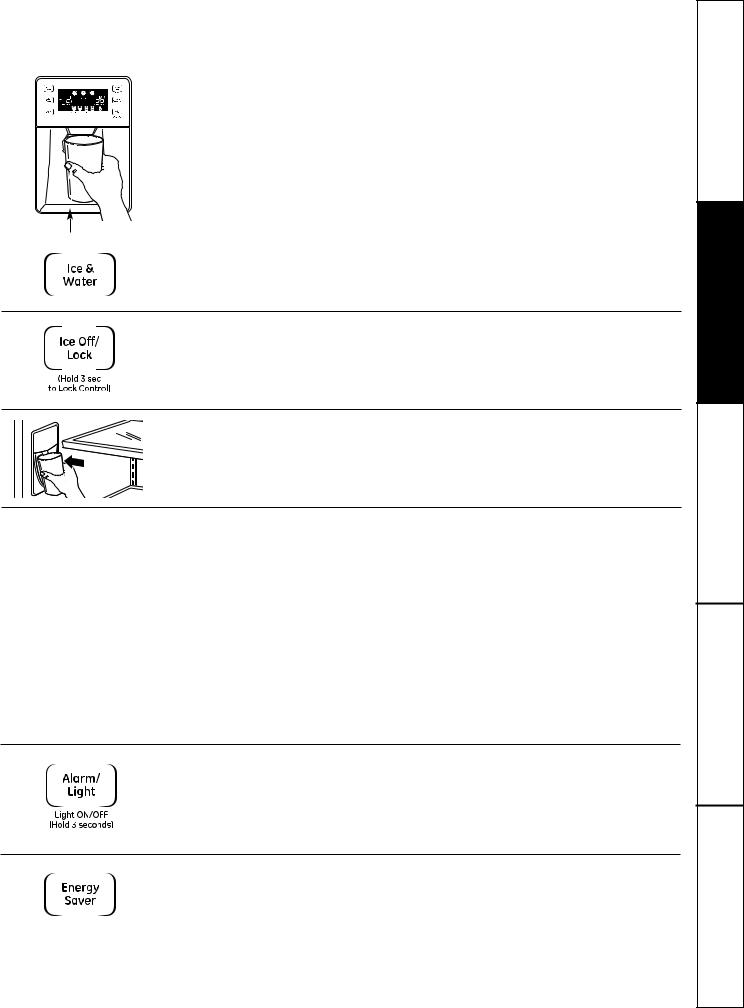
About the controls. |
ge.com |
To Use the Dispenser (on some models)
Select Cubed Ice  , Crushed Ice
, Crushed Ice  or
or
Water  by pressing the Ice & Water pad.
by pressing the Ice & Water pad.
Press the glass gently against the top of the dispenser cradle.
The spill shelf is not self-draining.
To reduce water spotting, the shelf should be cleaned regularly.
Spill Shelf
If no water is dispensed when the refrigerator is first installed, there may be air in the water line system. Press the dispenser arm for at least two minutes to remove trapped air from the water line and to fill the water system. To flush out impurities in the water line, throw away the first six full glasses of water.
 CAUTION:Never put fingers or any other objects into the ice crusher discharge opening.
CAUTION:Never put fingers or any other objects into the ice crusher discharge opening.
To Lock and Unlock the Dispenser (on some models)
To lock, press and hold the Ice Off/Lock pad for 3 seconds. Repeat this step to unlock the dispenser.
Internal Water Dispenser (on some models)
Push |
To use the internal water dispenser, place a |
glass underneath the water outlet and push |
|
|
gently against the dispenser with your glass. |
Important Facts About Your Dispenser
■Do not add ice from trays or bags to the storage drawer. It may not crush or dispense well.
■Avoid overfilling glass with ice and use of narrow glasses. Backed-up ice can jam the chute or cause the door in the chute to freeze shut. If ice is blocking the chute, poke it through with a wooden spoon.
■Beverages and foods should not be quick-chilled in the ice storage drawer. Cans, bottles or food packages
in the storage drawer may cause the icemaker or auger to jam.
■To keep dispensed ice from missing the glass,
put the glass close to, but not touching, the dispenser opening.
■Some crushed ice may be dispensed even though you selected Cubed Ice. This happens occasionally when a few cubes accidentally get directed to the crusher.
■After crushed ice is dispensed, some water may drip from the chute.
■Sometimes a small mound of snow will form on the door in the ice chute. This condition is normal and usually occurs when you have dispensed crushed ice repeatedly.
The snow will eventually evaporate.
About Door Alarm (on some models) |
About Dispenser Light (on some models) |
The door alarm will sound if any |
Press and hold the Alarm/Light pad for |
door is open for more than 3 minutes. |
3 seconds to turn on the dispenser light. |
The beeping stops when you close the door. |
To turn off, press and hold the pad again |
|
for 3 seconds. |
About Energy Saver
This product is equipped with an Energy Saver feature. The refrigerator is shipped with the Energy Saver feature on.
Over time, moisture can form on the front surface of the refrigerator cabinet and cause
rust. If moisture does appear on the front surface of the refrigerator cabinet, turn off the Energy Saver feature by pressing
and releasing the Energy Saver pad on the control panel.
5
Instructions Operating Instructions Safety
Instructions |
Installation |
Support Consumer Tips Troubleshooting
Downloaded from www.Manualslib.com manuals search engine
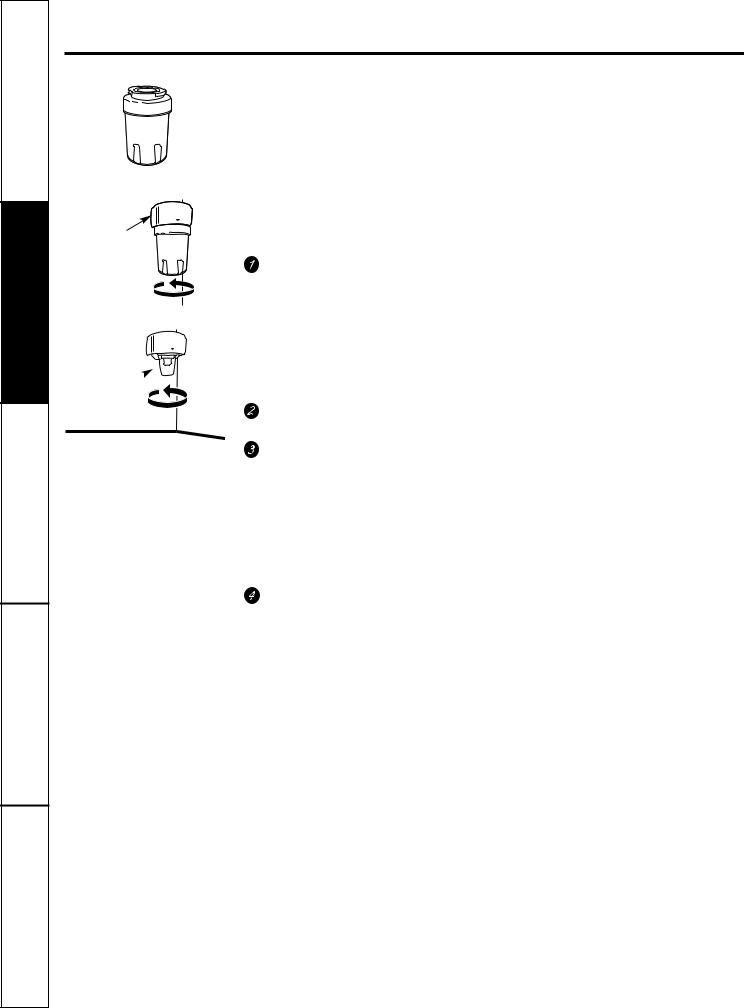
Operating Instructions Safety Instructions
Installation |
Instructions |
Consumer Support Troubleshooting Tips
About the water filter.
Cartridge
Holder
Filter 
Bypass
Plug
Water Filter Cartridge
The water filter cartridge is located in the back upper right corner
of the refrigerator compartment.
When to Replace the Filter
The filter cartridge should be replaced every six months or if the flow of water to the dispenser or icemaker decreases.
Installing the Filter Cartridge
If you are replacing the cartridge, first remove the old one by slowly turning it counterclockwise. A small amount of water may drip down.
 CAUTION: If air has been trapped in the system, the filter cartridge may be ejected as it is removed. Use caution when removing.
CAUTION: If air has been trapped in the system, the filter cartridge may be ejected as it is removed. Use caution when removing.
Remove the protective foil from the end of the cartridge.
Lining up the arrow on the cartridge and the cartridge holder, place the top of the new cartridge up inside the holder. Do not push it up into the holder. Slowly rotate the cartridge clockwise until it stops. As you turn the cartridge, it will automatically raise itself into position. Cartridge will rotate about 1/4 turn.
Do not overtighten.
Run water from the dispenser for
3 minutes (about 11⁄ 2 gallons) to clear the system and prevent sputtering. See To Use the Dispenser section.
NOTE: A newly installed water filter cartridge may cause water to spurt from the dispenser.
Filter Bypass Plug
You must use the filter bypass plug when a replacement filter cartridge is not available. The icemaker will not operate without
the filter or filter bypass plug.
Replacement Filters:
To order additional filter cartridges in the United States, visit our Website,
ge.com or call GE Parts and Accessories, 800.626.2002.
Filter Model MWF
Customers in Canada should consult the yellow pages for the nearest Mabe Service Center.
6
Downloaded from www.Manualslib.com manuals search engine
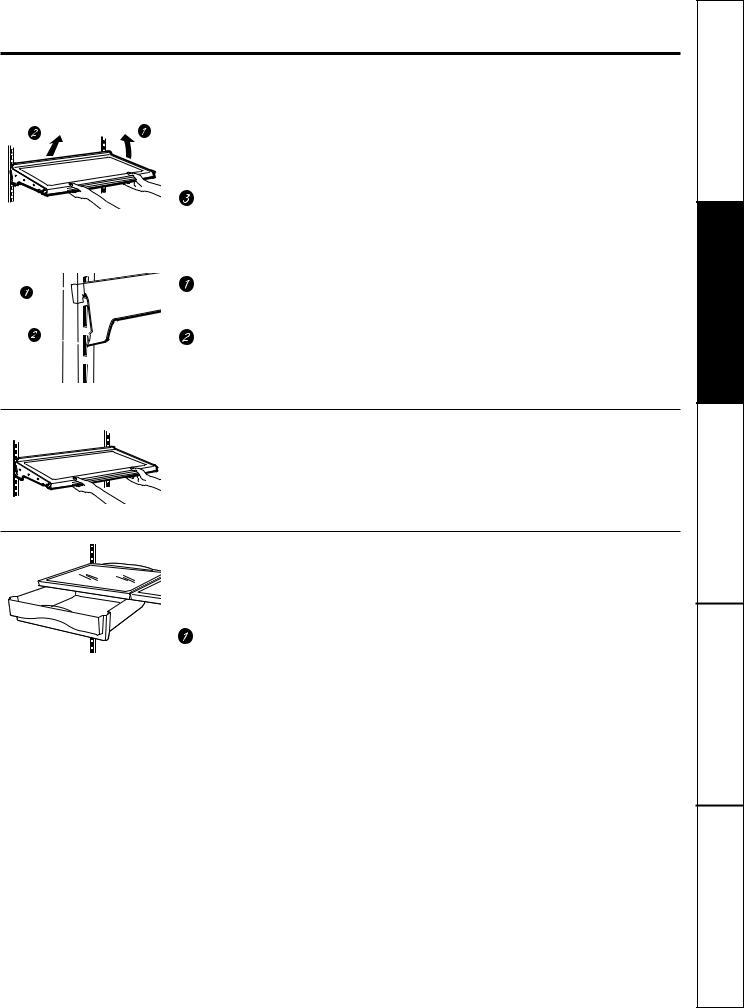
About fresh food storage options.
Rearranging the Shelves
Shelves in the refrigerator compartment are adjustable.
To remove:
 Remove all items from the shelf.
Remove all items from the shelf.
 Tilt the shelf up at the front.
Tilt the shelf up at the front.
Lift the shelf up at the back and bring the shelf out.
To replace:
While tilting the shelf up, insert the top hook at the back of the shelf in a slot on the track.
Lower the front of the shelf until
the bottom of the shelf locks into place.
Spillproof Shelves
Spillproof shelves have special edges to help prevent spills from dripping to lower shelves.
Floating snack pan
The location of the snack pan is adjustable and can be changed like the other shelves.
To remove:
Pull the snack pan out to the stop position.
 Lift the pan up and past the stop.
Lift the pan up and past the stop.
ge.com
7
Instructions Operating Instructions Safety
Instructions |
Installation |
Support Consumer Tips Troubleshooting
Downloaded from www.Manualslib.com manuals search engine
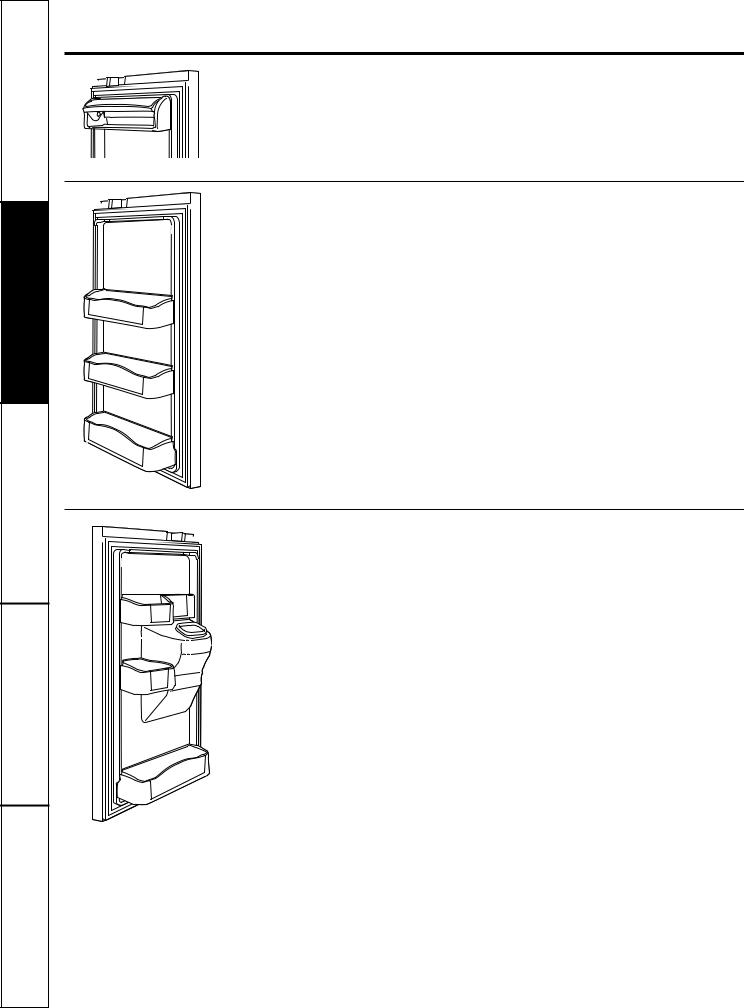
Operating Instructions Safety Instructions
Installation |
Instructions |
Consumer Support Troubleshooting Tips
About fresh food storage options.
Non-Adjustable Dairy Bin
To remove: Lift the dairy bin straight up, then |
To replace: Engage the bin in the molded |
pull out. |
door supports and push down. The bin will |
|
lock in place. |
Adjustable Bins on the Door
Adjustable bins can easily be carried from refrigerator to work area.
To remove: Lift bin straight up, then pull out.
To replace or relocate: Slide in the bin just above the molded door supports, and push down. The bin will lock in place.
NOTE: On models without a full-width pantry, the location of the bottom door bin is not adjustable.
Non-Adjustable Bins on the Door (on some models)
To remove: Lift the bin straight up, then pull out.
To replace: Engage the bin in the molded supports on the door and push down.
It will lock in place.
8
Downloaded from www.Manualslib.com manuals search engine

ge.com
Fruit and Vegetable Crisper
Keep fruits and vegetables organized
in separate compartments for easy access.
Excess water that may accumulate in the bottom of the drawers or under the drawers should be wiped dry.
|
Fruit |
|
|
|
|
Veg |
|
|
|
|
|
|
|
||
|
|
|
|
|
|
|
|
|
|
|
|
|
|
|
|
|
|
|
|
|
|
|
|
Adjustable Deli/Produce Drawer (on some models)
The Adjustable Deli/Produce Drawer is a full-width drawer with adjustable temperature control. This drawer can be used for large miscellaneous items.
There is a temperature control which can adjust the amount of cold air allowed into the drawer.
Control
When Produce Drawer is selected,
the temperature of the drawer can be kept around 38°F (3°C). This feature also helps keep food fresh for a long time.
When Deli Drawer is selected,
the temperature of the drawer can be kept around 34°F (1°C). This feature also helps keep meat or fish fresh for a longer time.
NOTE: Fruits and vegetables may be damaged using the Deli Drawer setting. Do not store lettuce or other leafy produce in this drawer.
 CAUTION:Do not store glass bottles in this drawer. If they are frozen, they can break and cause personal injury.
CAUTION:Do not store glass bottles in this drawer. If they are frozen, they can break and cause personal injury.
The control is located on the right side of the drawer.
How to Remove and Replace the Adjustable Deli/Produce Drawer
To remove:
 Pull the drawer out to the stop position.
Pull the drawer out to the stop position.  Lift the front of the drawer up and out.
Lift the front of the drawer up and out.
To replace:
 Lift the cover up.
Lift the cover up.
 Engage the pantry rollers into the side rails.
Engage the pantry rollers into the side rails.
Push the drawer inward (until it is in place).
How to Remove and Replace Drawer Divider
To remove: |
To replace: |
Pull the drawer out to the stop position. |
Hook the back of the divider over the rear |
Raise the front side of the divider |
wall of the drawer. |
|
|
to unhook it from the rear wall of |
Push the divider down. |
the drawer. |
|
9
Instructions Operating Instructions Safety
Instructions |
Installation |
Support Consumer Tips Troubleshooting
Downloaded from www.Manualslib.com manuals search engine
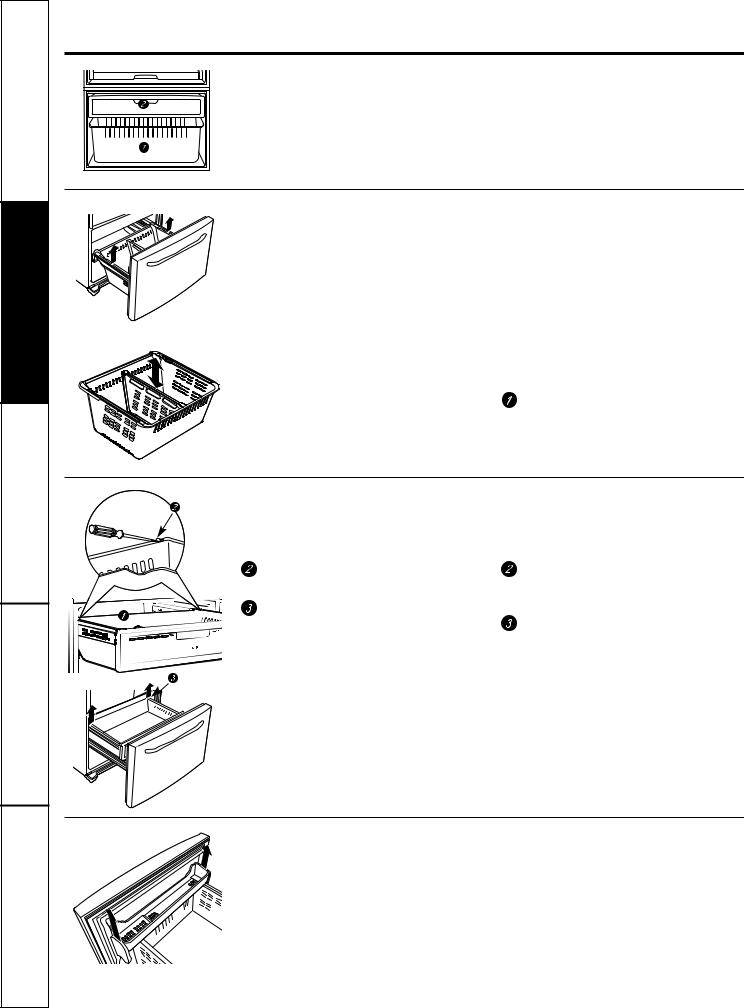
Operating Instructions Safety Instructions
Installation |
Instructions |
Consumer Support Troubleshooting Tips
About the freezer.
Freezer Basket and Drawer
 Basket.
Basket.
 Drawer.
Drawer.
Basket Removal
To remove:
 Remove Freezer Bin. (See below.)
Remove Freezer Bin. (See below.)
 Pull basket out to the stop position.
Pull basket out to the stop position.
 Tilt up the rear of the bin.
Tilt up the rear of the bin.  Lift it out to remove.
Lift it out to remove.
To replace:
 Place the basket into the rail assembly.
Place the basket into the rail assembly.
Basket Divider Removal
To remove:
 Pull basket out to the stop position.
Pull basket out to the stop position.
 Tilt up the rear of the bin.
Tilt up the rear of the bin.  Lift it out to remove.
Lift it out to remove.
To replace:
Hook the top corners of the divider over the hole of the basket.
Drawer Removal
To remove:
 Pull the drawer out to the stop position.
Pull the drawer out to the stop position.
Remove both side knobs with a flat-head screwdriver (as shown at left).
Tilt up the rear of the drawer and lift drawer up and out.
To replace:
 Pull both rails out to the stop position.
Pull both rails out to the stop position.
Place the drawer onto the rails and hook the support into the slots located on the side of the drawer.
Replace the side knobs and push the drawer back into place.
 WARNING:Do not lose the side knobs during disassembly since they may present a choking hazard to children.
WARNING:Do not lose the side knobs during disassembly since they may present a choking hazard to children.
Non-Adjustable Bin in the Freezer
To remove: Pull the brackets upward until you hear a clicking sound and remove the bin.
To replace: Hook the ends of the bin into both brackets and push down until the bin locks into place.
10
Downloaded from www.Manualslib.com manuals search engine
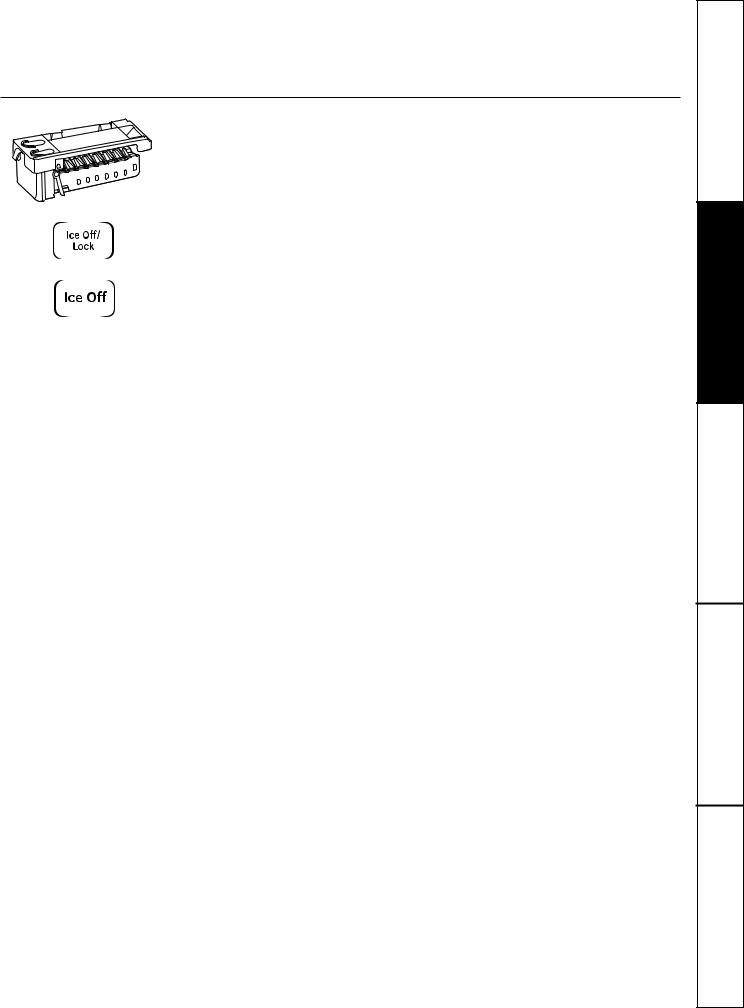
About the automatic icemaker. |
ge.com |
A newly installed refrigerator may take 12 to 24 hours to begin making ice.
Automatic Icemaker
The icemaker will produce seven cubes per cycle—approximately 100–130 cubes in a 24-hour period, depending on freezer compartment temperature, room temperature, number of door openings and other use conditions.
If the refrigerator is operated before the water connection is made to the icemaker, press and release the Ice Off/Lock or Ice Off pad on the control panel to disengage the icemaker.
When the refrigerator has been connected to the water supply, press and release the
Ice Off/Lock or Ice Off pad on the control panel to engage the icemaker.
A newly installed refrigerator may take 12 to 24 hours to begin making ice cubes.
You will hear a buzzing sound each time the icemaker fills with water.
Throw away the first few batches of ice to allow the water line to clear.
Be sure nothing interferes with the sweep of the feeler arm.
When the bin fills to the level of the feeler arm, the icemaker will stop producing ice. It is normal for several cubes to be joined together.
If ice is not used frequently, old ice cubes will become cloudy, taste stale and shrink.
NOTE: In homes with lower-than-average water pressure, you may hear the icemaker cycle multiple times when making one batch of ice.
NOTE: Turn on the Ice Off feature if the water supply is shut off.
11
Instructions Operating Instructions Safety
Instructions |
Installation |
Support Consumer Tips Troubleshooting
Downloaded from www.Manualslib.com manuals search engine

Operating Instructions Safety Instructions
Installation |
Instructions |
Consumer Support Troubleshooting Tips
Care and cleaning of the refrigerator.
Cleaning the Outside
The door handles and trim. Clean with a cloth dampened with soapy water. Dry
with a soft cloth. Do not use wax on the door handles and trim.
Keep the outside clean. Wipe with
a clean cloth lightly dampened with kitchen appliance wax or mild liquid dish detergent. Dry and polish with a clean, soft cloth.
Do not wipe the refrigerator with a soiled dish cloth or wet towel. These may leave a residue that can erode the paint. Do not use scouring pads, powdered cleaners, bleach or cleaners containing bleach because these products can scratch
and weaken the paint finish.
The stainless steel panels and door handles. Stainless steel (on some models) can be cleaned with a commercially available stainless steel cleaner. A spray-on stainless steel cleaner works best.
Do not use appliance wax or polish on the stainless steel.
Silver-accented plastic parts. Wash parts with soap or other mild detergents. Wipe clean with a sponge, damp cloth or paper towel.
Do not scrub with steel-wool pads or other abrasive cleaners.
Cleaning the Inside
To help prevent odors, leave an open box of baking soda in the refrigerator and freezer compartments.
Unplug the refrigerator before cleaning.
If this is not practical, wring excess moisture out of sponge or cloth when cleaning around switches, lights or controls.
Use an appliance wax polish on the inside surface between the doors.
Use warm water and baking soda solution— about a tablespoon (15 ml) of baking soda to a quart (1 liter) of water. This both cleans and neutralizes odors. Rinse and wipe dry.
After cleaning the door gaskets, apply a thin layer of petroleum jelly to the door gaskets at the hinge side. This helps keep the gaskets from sticking and bending out of shape.
Avoid cleaning cold glass shelves with hot water because the extreme temperature difference may cause them to break. Handle glass shelves carefully. Bumping tempered glass can cause it to shatter.
Do not wash any plastic refrigerator parts in the dishwasher.
Silver-accented plastic parts. Wash parts with soapy water. Wipe clean with a sponge, damp cloth or paper towel.
Do not scrub with steel-wool pads or other abrasive cleaners.
12
Downloaded from www.Manualslib.com manuals search engine
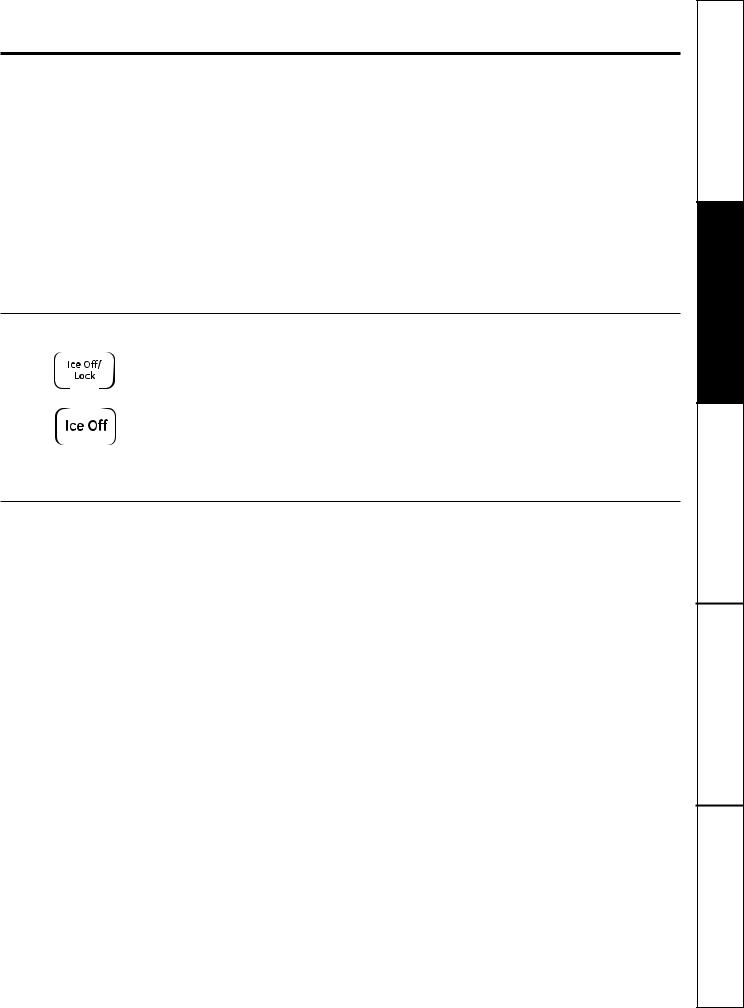
ge.com
Behind the Refrigerator
Be careful when moving the refrigerator away from the wall. All types of floor coverings can be damaged, particularly cushioned coverings and those with embossed surfaces.
Raise the leveling legs located
at the bottom front of the refrigerator.
See Level the Refrigerator in the Installation Instructions for leveling leg details.
Pull the refrigerator straight out and return it to position by pushing it straight in. Moving the refrigerator in a side direction may result
in damage to the floor covering or refrigerator.
Lower the leveling legs until they touch the floor.
When pushing the refrigerator back, make sure you don’t roll over the power cord
or icemaker supply line (on some models) and ensure the anti-tip bracket is engaged (if equipped).
Preparing for Vacation
For long vacations or absences, remove food and unplug the refrigerator. Clean the interior with a baking soda solution of
one tablespoon (15 ml) of baking soda to one quart (1 liter) of water. Leave the doors open.
Press and release the Ice Off/Lock or Ice Off pad on the control panel to disengage the icemaker.
If the temperature can drop below freezing, have a qualified servicer drain the water supply system (on some models) to prevent serious property damage due to flooding.
Preparing to Move
Secure all loose items such as base grille, shelves and drawers by taping them securely in place to prevent damage.
When using a hand truck to move the refrigerator, do not rest the front or back of the refrigerator against the hand truck. This could damage the refrigerator. Handle only from the sides of the refrigerator.
Be sure the refrigerator stays in an upright position during moving.
13
Instructions Operating Instructions Safety
Instructions |
Installation |
Support Consumer Tips Troubleshooting
Downloaded from www.Manualslib.com manuals search engine
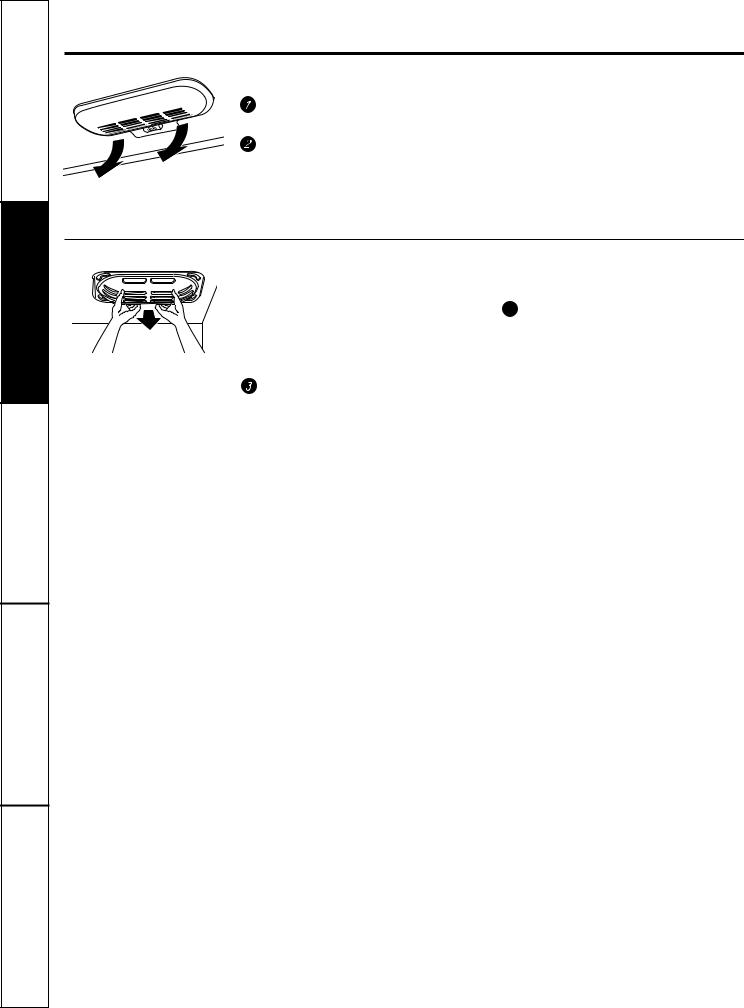
Operating Instructions Safety Instructions
Installation |
Instructions |
Consumer Support Troubleshooting Tips
Replacing the light bulbs.
Refrigerator Lights
Unplug the power cord from the outlet.
Rotate the shield down while depressing the two tabs on the back side of
the cover to remove it.
 Turn the bulb counterclockwise.
Turn the bulb counterclockwise.
 Replace with an appliance bulb of the same or lower wattage.
Replace with an appliance bulb of the same or lower wattage.
 Replace the shield.
Replace the shield.
 Plug the refrigerator back in.
Plug the refrigerator back in.
NOTE: Reveal® appliance bulbs may be ordered from GE Parts and Accessories, 800.626.2002.
Freezer Light
 CAUTION: Light bulbs may be hot.
CAUTION: Light bulbs may be hot.
 Unplug the power cord from the outlet.
Unplug the power cord from the outlet.
 Pull drawer out to the stop position.
Pull drawer out to the stop position.
Rotate the shield down while pushing it backwards to remove it.
 Turn the bulb counterclockwise.
Turn the bulb counterclockwise.
 Replace with an appliance bulb of the same or lower wattage.
Replace with an appliance bulb of the same or lower wattage.
 Replace the shield.
Replace the shield.
 Plug the refrigerator back in.
Plug the refrigerator back in.
NOTE: Reveal® appliance bulbs may be ordered from GE Parts and Accessories, 800.626.2002.
14
Downloaded from www.Manualslib.com manuals search engine
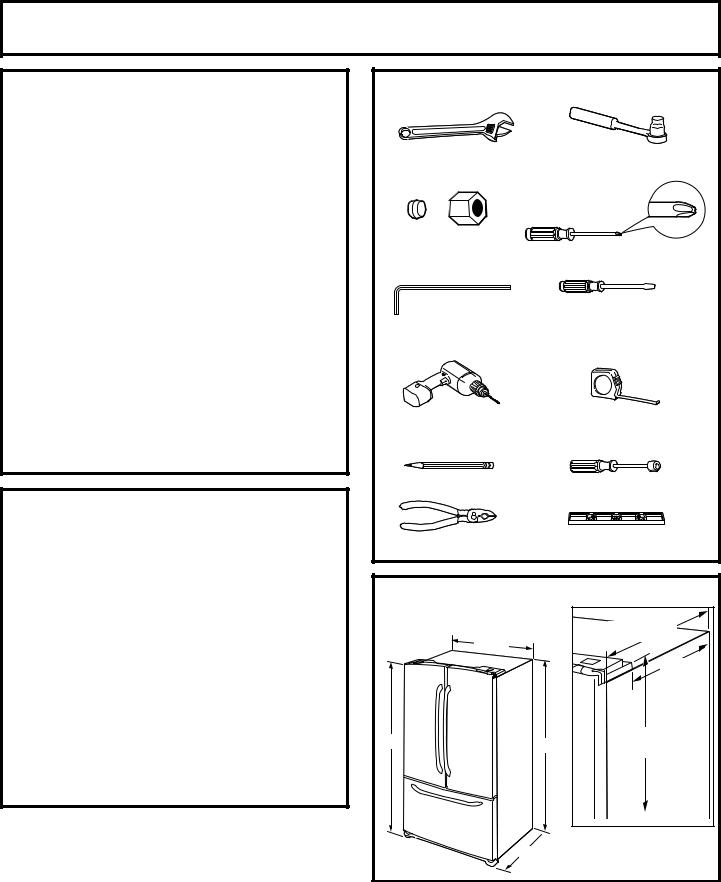
Installation |
Refrigerator |
Instructions |
GE Model 26 |
Questions? Call 800.GE.CARES (800.432.2737) or Visit our Website at: ge.com
In Canada, call 1.800.561.3344 or Visit our Website at: www.geappliances.ca
BEFORE YOU BEGIN
Read these instructions completely and carefully.
• IMPORTANT — Save these instructions for local inspector’s use.
• IMPORTANT — Observe all governing codes and ordinances.
•Note to Installer – Be sure to leave these instructions with the Consumer.
•Note to Consumer – Keep these instructions for future reference.
•Skill level – Installation of this appliance requires basic mechanical skills.
•Completion time – Refrigerator Installation
20 minutes
Water Line Installation
30minutes
•Proper installation is the responsibility of the installer.
•Product failure due to improper installation is not covered under the Warranty.
PREPARATION
MOVING THE REFRIGERATOR INDOORS
If the refrigerator will not fit through a doorway,
the refrigerator doors and freezer drawer can be removed.
•To remove the refrigerator door, see the Installing the Refrigerator section.
•To remove the freezer drawer, see the Removing the Freezer Drawer section.
WATER SUPPLY TO THE ICEMAKER AND DISPENSER
If the refrigerator has an icemaker, it will have to be connected to a cold water line. A GE water supply kit (containing tubing, shutoff valve, fittings and instructions) is available at extra cost from your dealer, by visiting our Website at ge.com (in Canada at www.geappliances.ca) or from Parts and Accessories, 800.626.2002
(In Canada 1.888.261.3055).
TOOLS YOU MAY NEED |
|||
Adjustable Wrench |
10 mm Socket |
||
Ratchet/Driver |
|||
|
|
||
1/4″ Outer Diameter |
|
||
Compression Nut |
|
Phillips-Head Screwdriver |
|
and Ferrule (sleeve) |
|
||
|
|
||
|
|
Flat-Head Screwdriver |
|
3/32″ , 1/8″, 3/16″ and |
|
||
4 mm Allen Wrenches |
|
||
1/8″ Drill Bit and |
|
Tape Measure |
|
Electric or Hand Drill |
|
|
|
Pencil |
|
1/4″ Nut Driver |
|
|
|
||
Pliers |
|
Level |
|
DIMENSIONS |
|
|
|
|
|
Case Depth w/o |
|
353⁄ |
4″ |
Doors 291⁄8″ |
|
|
|||
|
|
225⁄8″ |
|
70″ |
681⁄2″ |
Height from |
7 |
||
|
|
floor to hinge |
|
|
cover top 68 ⁄8″ |
 Additional Dimensions 351⁄2″
Additional Dimensions 351⁄2″
15
Downloaded from www.Manualslib.com manuals search engine
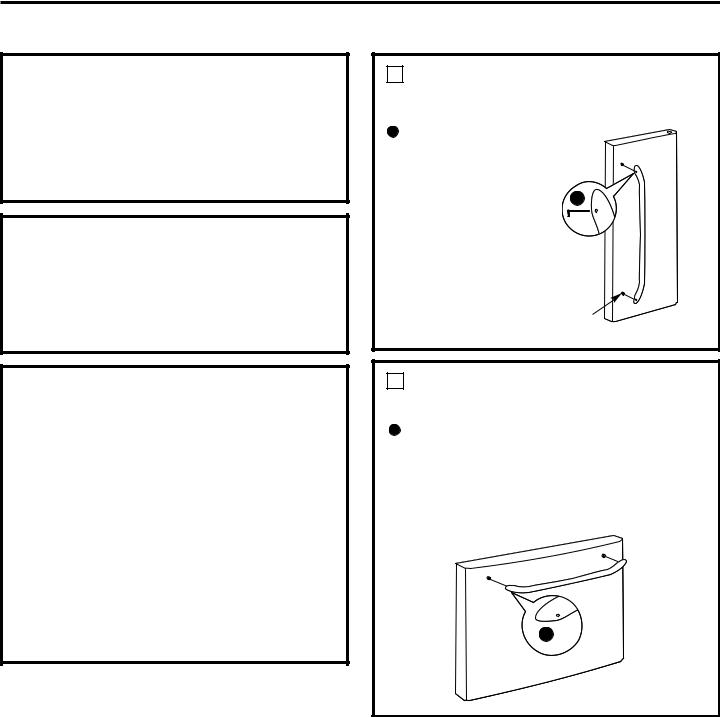
Installation Instructions
INSTALLING THE REFRIGERATOR
REFRIGERATOR LOCATION
•Do not install the refrigerator where the temperature will go below 60°F (16°C) because it will not run often enough to maintain proper temperatures.
•Do not install the refrigerator where the temperature will go above 100°F (37°C) because it will not perform properly.
•Install it on a floor strong enough to support it fully loaded.
CLEARANCES
Allow the following clearances for ease of installation, proper air circulation and plumbing and electrical connections.
Sides |
1/8″ (3 mm) |
Top |
1″ (25 mm) |
Back |
1″ (25 mm) |
REMOVING THE REFRIGERATOR DOORS
•IMPORTANT NOTE: This refrigerator is 35.6″ deep. Doors and passageways leading to the installation location must be at least 36″ wide in order to leave the doors and handles attached to the refrigerator while transporting it into the installation location. If passageways are less than 36″ , the refrigerator doors and handles can easily be scratched and damaged. The top cap and doors can be removed to allow the refrigerator to be safely moved indoors. Start with Step 1.
•If it is not necessary to remove doors, skip to Step 9. Leave tape and all packaging on doors until the refrigerator is in the final location.
•NOTE: Use a padded hand truck to move this refrigerator. Place the refrigerator on the hand truck with a side against the truck. We strongly recommend that TWO PEOPLE move and complete this installation.
1REMOVE THE FRESH FOOD DOOR HANDLE
Stainless steel and plastic handles:
A REMOVING THE DOOR |
|
HANDLE: Loosen |
|
the set screws |
|
with the 1/8″ |
|
Allen wrench |
A |
and remove |
|
the handle. |
|
NOTE: If the handle |
|
mounting fasteners |
|
need to be tightened |
|
or removed, use |
|
a Phillips-head |
Mounting |
screwdriver. |
Fasteners |
2 REMOVE THE FREEZER DOOR HANDLE
Stainless steel and plastic handles:
ALoosen the set screws located on the underside of the handle with the 1/8″ Allen wrench and remove the handle.
NOTE: If the handle mounting fasteners need to be tightened or removed, use a Phillips-head screwdriver.
A
16
Downloaded from www.Manualslib.com manuals search engine
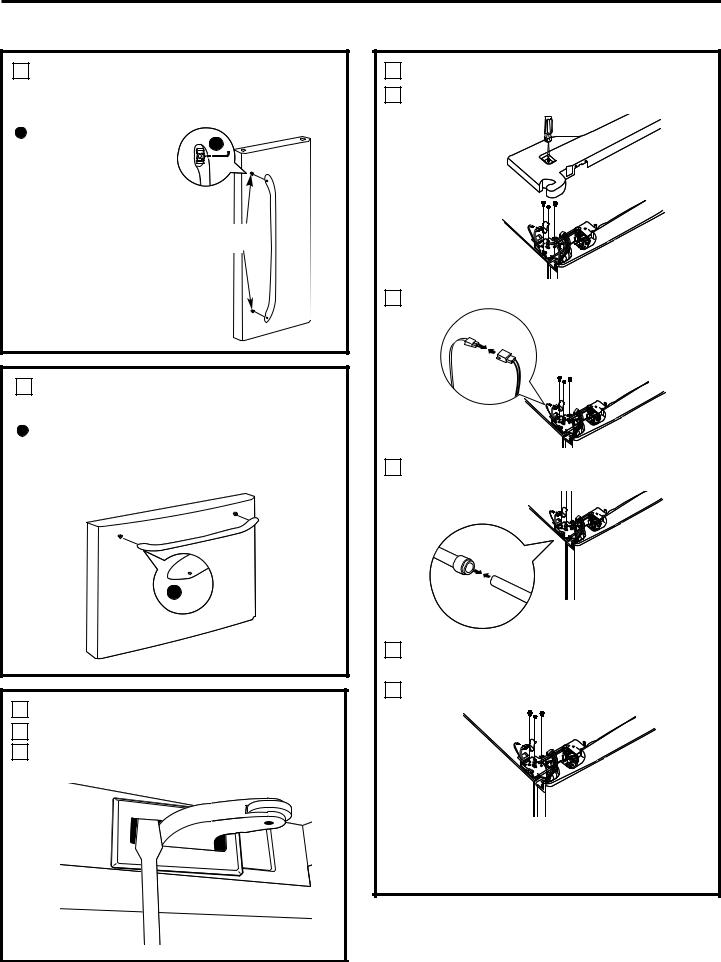
Installation Instructions
3ATTACH THE FRESH FOOD DOOR HANDLE
Stainless steel and plastic handles:
A Attach the handle
to the handle |
A |
mounting fasteners and tighten the set screws with a 1/8″ Allen wrench.
Mounting
Fasteners
4 ATTACH THE FREEZER DOOR HANDLE
Stainless steel and plastic handles:
AAttach the handle firmly to the mounting
fasteners and tighten the set screws on the bottom of the handle with a 1/8″ Allen wrench.
A 
5 REMOVE THE REFRIGERATOR DOORS
A Open the refrigerator doors.
BRemove the two rectangular caps with a flat-head screwdriver.
5 REMOVE THE REFRIGERATOR DOORS (cont.)
CRemove the three screws on top with a Phillips-head screwdriver.
D Disengage the two electrical connectors.
ETo disconnect the water coupling, push in on the gray color of the coupling and pull out the tubing.
FRemove the two grounding cables with a Phillips-head screwdriver.
GRemove three 10 mm hex-head bolts (right and left).
 CAUTION: When the bolts are removed, the door may fall and cause personal injury and/or damage to the door itself.
CAUTION: When the bolts are removed, the door may fall and cause personal injury and/or damage to the door itself.
17
Downloaded from www.Manualslib.com manuals search engine

Installation Instructions
INSTALLING THE REFRIGERATOR (cont.)
5 REMOVE THE REFRIGERATOR DOORS (cont.)
H Lift the door straight up to remove.
IRemove
and two Phillips-head screws from the center hinge. Set the hinge, bolts and screw aside.
6 REPLACING THE REFRIGERATOR DOORS
A Install the center hinge on each side.
BLower the refrigerator door onto the center hinge pin. Ensure that the plastic hinge pin thimble is on the center hinge pin
bottom of
CSecurely tape the door shut with masking tape or have a second person support the door.
6
D
E
F
G
H
REPLACING THE REFRIGERATOR DOORS
(cont.)
Insert the top hinge pin into the hinge hole on top
of the refrigerator door. Make sure the door is aligned with the cabinet and opposite door. Attach the hinge to the top of the cabinet. Do not tighten bolts completely.
On left-hand doors, pass the wires and water line through the top hinge pin. Then connect the water line and two connectors.
Attach the ground wire with a Phillips-head screwdriver at the right and left hinge.
Make sure the gasket on the door is flush against the cabinet and is not folded. Make sure the door is straight and the gap between the doors is even across the front. While holding the aligned door in place, tighten the top hinge bolts.
Reconnect the two connectors at each side of the top cap and reattach the three Phillips-head screws on top.
I Reinstall the rectangular caps removed in Step 5.
18
Downloaded from www.Manualslib.com manuals search engine
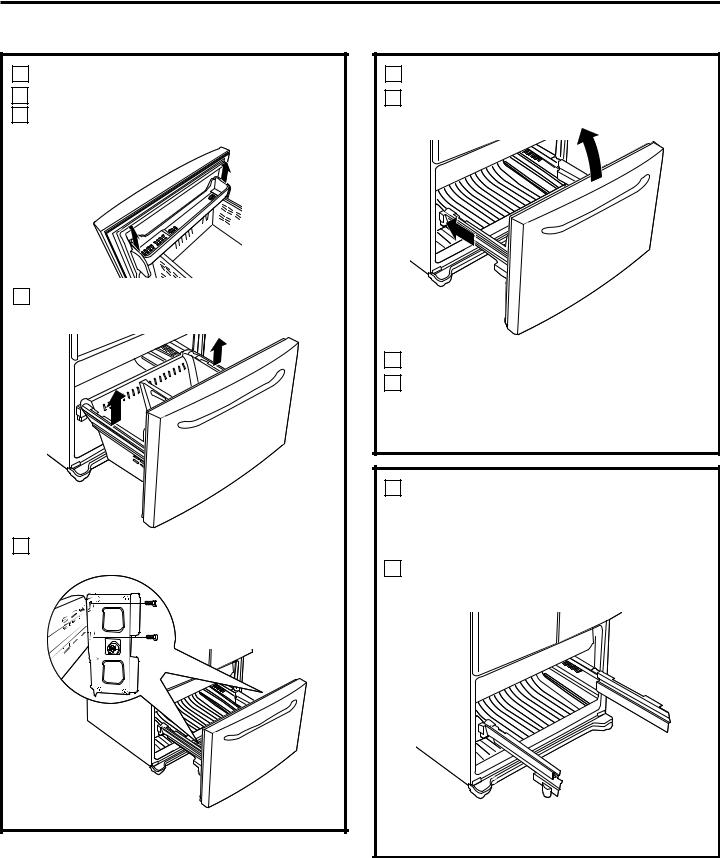
Installation Instructions
7 REMOVE THE FREEZER DOOR
A Pull the freezer door open to full extension.
BRemove the freezer bin by pulling both brackets upward at the same time. (See page 10.)
CTake out the lower basket by lifting the basket up from the rail system. (See page 10.)
DRemove the two 10 mm hex-head bolts from the right and left side.
7 REMOVE THE FREEZER DOOR (cont.)
EUse the tip of a screwdriver to separate the rail from the rail cover. Tilt the front end up and lift the entire door.
FSet the door front on a nonscratching surface.
GPush the rail assemblies back into the cabinet.
 CAUTION:Push both sides of the rail assemblies back at the same time.
CAUTION:Push both sides of the rail assemblies back at the same time.
8 REPLACING THE FREEZER DOOR
Two people may be required to complete this procedure.
ATTACH AND SECURE THE DRAWER FRONT TO THE SLIDES
APull out the rail assemblies to the full length on each side of the cabinet.
 CAUTION:Make sure to pull out the side rails evenly.
CAUTION:Make sure to pull out the side rails evenly.
19
Downloaded from www.Manualslib.com manuals search engine
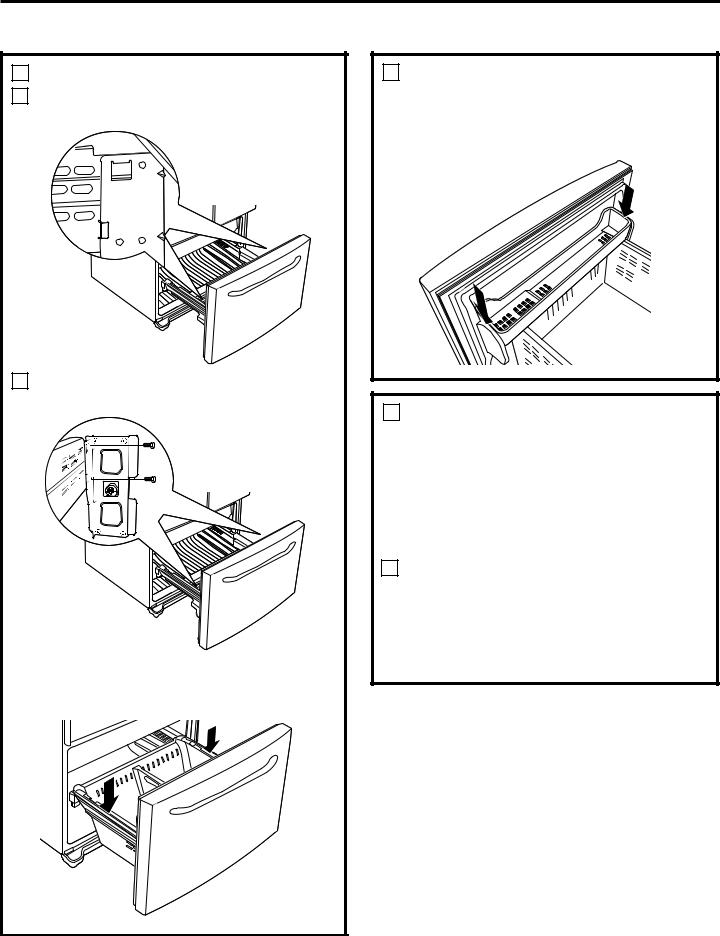
Installation Instructions
INSTALLING THE REFRIGERATOR
8 REPLACING THE FREEZER DOOR (cont.)
BHang the freezer door front onto open slots on the sides.

 Slot
Slot
CTighten screws completely. (There are four 10 mm hex-head bolts.)
REPLACE THE FREEZER BASKET
Replace the freezer basket by lowering it into the frame.
(cont.)
8 REPLACING THE FREEZER DOOR (cont.)
REPLACE THE FREEZER BIN
Hook the ends of the freezer bin into both brackets, and push down until they lock into place. (See page 10.)
9CONNECTING THE REFRIGERATOR TO THE HOUSE WATER LINE
A cold water supply is required for automatic icemaker operation. If there is not a cold water supply, you will need to provide one. See Installing the Water Line section.
NOTE: Before making the connection to the refrigerator, be sure the refrigerator power cord is not plugged
into the wall outlet.
AIf you are using copper tubing, place
a compression nut and ferrule (sleeve) onto the end of the tubing coming from the house cold water supply.
If you are using the GE SmartConnect™ tubing, the nuts are already assembled to the tubing.
20
Downloaded from www.Manualslib.com manuals search engine
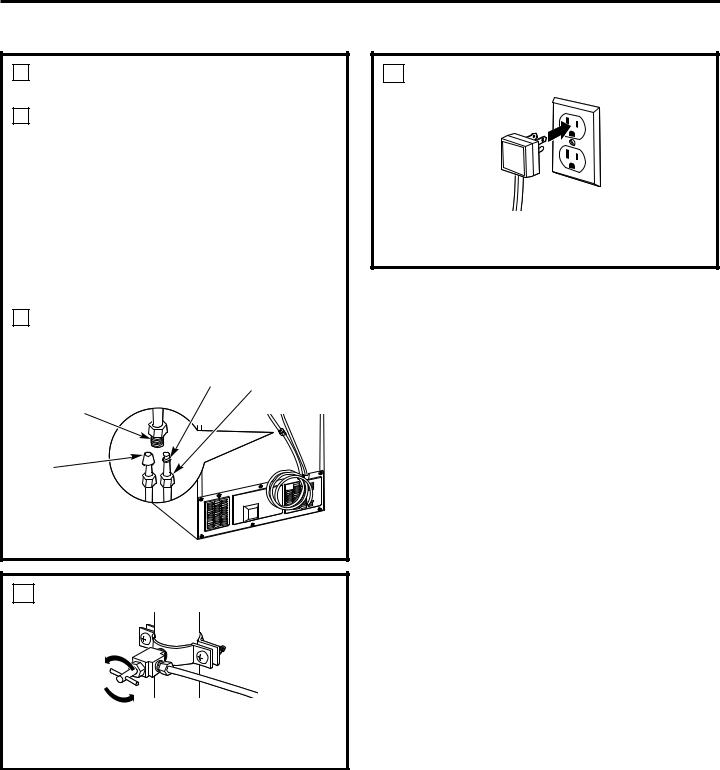
Installation Instructions
9CONNECTING THE REFRIGERATOR TO THE HOUSE WATER LINE (cont.)
BIf you are using copper tubing, insert the end of the tubing into the refrigerator connection, at the back of the refrigerator,
as far as possible. While holding the tubing, tighten the fitting.
If you are using GE SmartConnect™ tubing, insert the molded end of the tubing into
the refrigerator connection, at the back
of the refrigerator, and tighten the compression nut until it is hand tight. Then tighten one additional turn with a wrench. Overtightening may cause leaks.
CFasten the tubing into the clamp provided to hold it in position. You may need to pry open the clamp.
Ferrule |
1/4″ |
(sleeve) |
Compression |
|
Nut |
Refrigerator
Connection
SmartConnect™
Tubing
11 PLUG IN THE REFRIGERATOR
See the grounding information attached to the power cord.
10 TURN ON THE WATER SUPPLY
Turn the water on at the shutoff valve
(house water supply) and check for any leaks.
21
Downloaded from www.Manualslib.com manuals search engine
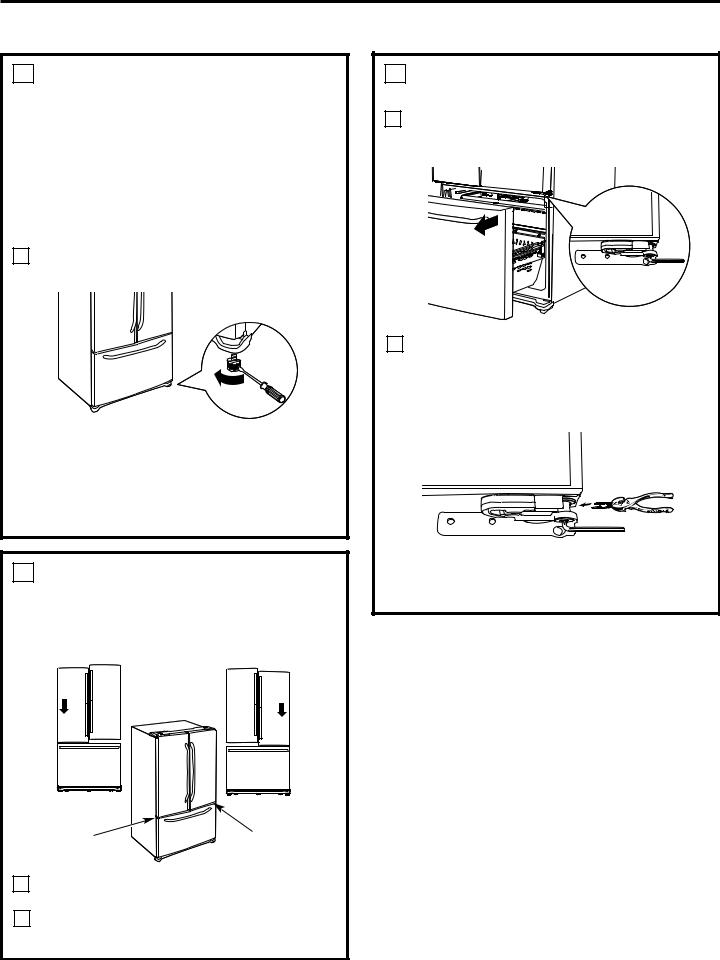
Installation Instructions
INSTALLING THE REFRIGERATOR (cont.)
12 LEVEL THE REFRIGERATOR
The leveling legs have 2 purposes:
1)Leveling legs adjust so the refrigerator is firmly positioned on the floor and does not wobble.
2)Leveling legs serve as a stabilizing brake to hold the refrigerator securely in position during operation and cleaning. The leveling legs also prevent the refrigerator from tipping.
ATurn the leveling legs clockwise to raise
the refrigerator, counterclockwise to lower it.
Flat-Head Screwdriver
 CAUTION: To avoid possible personal injury or property damage, the leveling legs must be firmly touching the floor.
CAUTION: To avoid possible personal injury or property damage, the leveling legs must be firmly touching the floor.
13 LEVEL THE REFRIGERATOR DOORS
Remember a level refrigerator is necessary for getting the doors perfectly even. If you need help, review the previous section on leveling the refrigerator.
When |
When |
the left |
the left |
door is |
door is |
lower |
higher |
than the |
than the |
right |
right |
door. |
door. |
Adjustment |
Adjustment |
point |
point |
AIf you open the freezer door, you can see the center hinge.
BInsert the supplied 4 mm Allen wrench into the shaft of the center hinge.
13LEVEL THE REFRIGERATOR DOORS (cont.)
CAdjust the height by turning clockwise or counterclockwise. When you turn counterclockwise, the door will move up.
DAfter adjusting the doors, insert the supplied fastener ring using a pair of pliers in the gap between the hinge grommet and the center hinge. The number of fastener rings you will need to insert depends on the gap.
NOTE: Four fastener rings are enclosed with the refrigerator. Thickness of each fastener ring is 0.04″ .
22
Downloaded from www.Manualslib.com manuals search engine
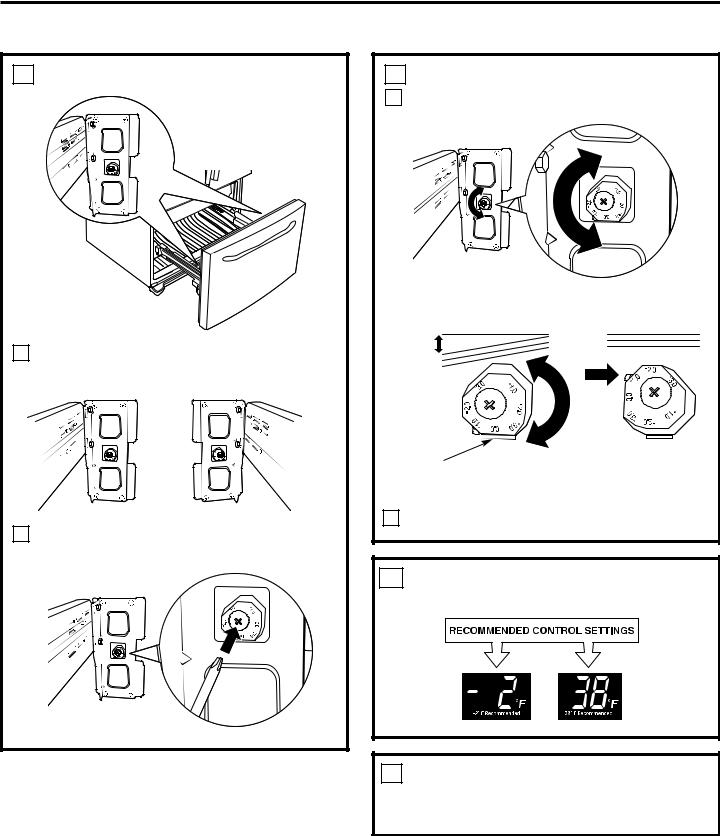
Installation Instructions
14 LEVEL THE FREEZER DOOR
ALocate the height adjuster in the freezer door. Slightly loosen the four Phillips-head screws from the door on each side (right and left).
BLoosen the controller screw with a Phillips-head screwdriver to adjust the level.
14 LEVEL THE FREEZER DOOR (cont.)
C Find the best position to align the door slope.
Example: The slope is about 2 mm as shown below.
Slope
Reference |
Rotate the height adjuster to +2.0 |
Plane |
to reduce the door slope. |
DAfter adjustment, tighten all the screws.
15 SET THE CONTROLS
Set the controls to the recommended setting.
16REMOVE PACKAGING
A)Remove all tape, foam and protective packing from shelves and drawers.
23
Downloaded from www.Manualslib.com manuals search engine
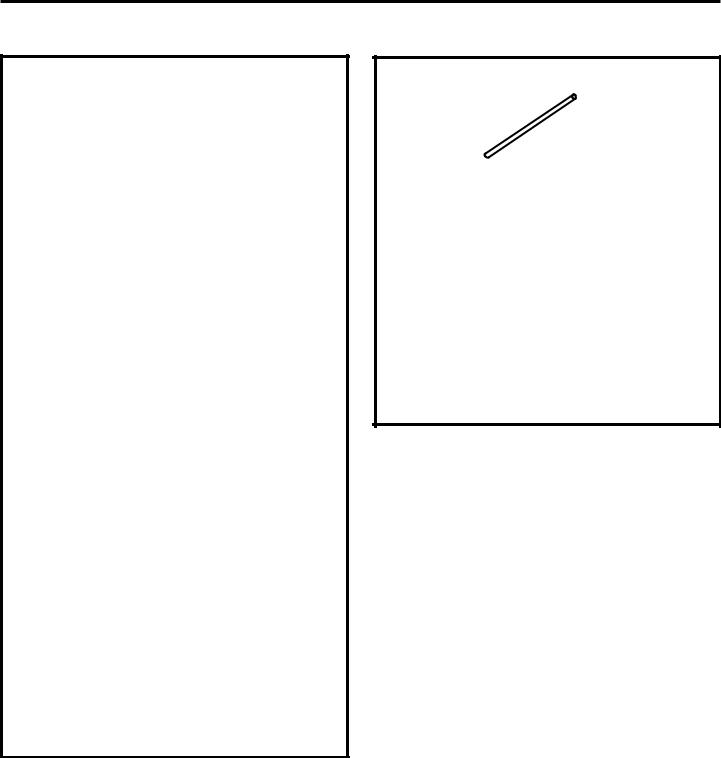
Installation Instructions
INSTALLING THE WATER LINE
BEFORE YOU BEGIN
Recommended copper water supply kits are WX8X2, WX8X3 or WX8X4, depending on the amount of tubing you need. Approved plastic water supply lines are GE SmartConnect™ Refrigerator Tubing (WX08X10006, WX08X10015 and WX08X10025).
When connecting your refrigerator to a GE Reverse Osmosis Water System, the only approved installation is with a GE RVKit. For other reverse osmosis water systems, follow the manufacturer’s recommendations. If the water supply to the refrigerator is from
a Reverse Osmosis Water Filtration System AND the refrigerator also has a water filter, use the refrigerator’s filter bypass plug. Using the refrigerator’s water filtration cartridge in conjunction with the MWF filter can result
in hollow ice cubes.
This water line installation is not warranted by the refrigerator or icemaker manufacturer. Follow these instructions carefully to minimize the risk of expensive water damage.
Water hammer (water banging in the pipes) in house plumbing can cause damage to refrigerator parts and lead to water leakage or flooding. Call a qualified plumber to correct water hammer before installing the water supply line to the refrigerator. To prevent burns and product damage, do not hook up the water line to the hot water line.
If you use your refrigerator before connecting the water line, disable the icemaker by turning the Ice Off feature ON. See About the Automatic Icemaker for more information.
Do not install the icemaker tubing in areas where temperatures fall below freezing.
When using any electrical device (such as a power drill) during installation, be sure the device is double insulated or grounded in a manner to prevent the hazard of electric shock, or is battery powered.
All installations must be in accordance with local plumbing code requirements.
WHAT YOU WILL NEED
•Copper or GE SmartConnect™ Refrigerator Tubing kit, 1/4″ outer diameter to connect the refrigerator to the water supply. If using copper, be sure both ends of the tubing are cut square.
To determine how much tubing you need: measure the distance from the water valve on the back of the refrigerator to the water supply pipe. Be sure there is sufficient extra tubing to allow the refrigerator to move out from the wall after installation.
GE SmartConnect™ Refrigerator Tubing Kits are available in the following lengths:
6′ (1.8 m) – WX08X10006
15′ (4.6 m) – WX08X10015
25′ (7.6 m) – WX08X10025
24
Downloaded from www.Manualslib.com manuals search engine
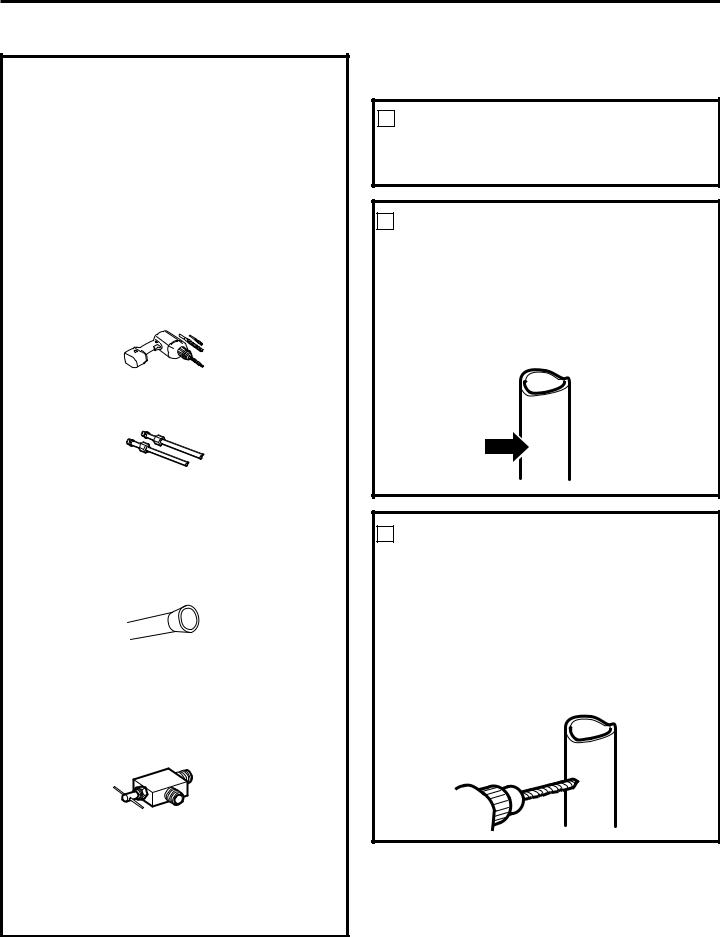
Installation Instructions
WHAT YOU WILL NEED (CONT.)
NOTE: The only GE approved plastic tubing is that supplied in GE SmartConnect™
Refrigerator Tubing kits. Do not use any other plastic water supply line because the line is under pressure at all times. Certain types of plastic will crack or rupture with age and cause water damage to your home.
•A GE water supply kit (containing tubing, shutoff valve and fittings listed below) is available at extra cost from your dealer or from Parts
and Accessories, 800.626.2002 (in Canada 1.888.261.3055).
•A cold water supply. The water pressure must be between 20 and 120 p.s.i. (1.4–8.1 bar).
•Power drill.
•1/2″ or adjustable wrench.
•Straight and Phillips blade screwdriver.
•Two 1/4″ outer diameter compression nuts and 2 ferrules (sleeves)—to connect the copper tubing to the shutoff valve and the refrigerator water valve.
OR
•If you are using a GE SmartConnect™ Refrigerator Tubing kit, the necessary fittings are preassembled to the tubing.
•If your existing copper water line has a flared fitting at the end, you will need an adapter (available at plumbing supply stores) to connect the water line to the refrigerator OR you can cut off the flared fitting with a tube cutter and then use a compression fitting. Do not cut formed end from GE SmartConnect™ Refrigerator tubing.
•Shutoff valve to connect to the cold water line.
The shutoff valve should have a water inlet with a minimum inside diameter of 5/32″ at the point of connection to the COLD WATER LINE. Saddle-type shutoff valves are included in many water supply kits. Before purchasing, make sure a saddle-type valve complies with your local plumbing codes.
Install the shutoff valve on the nearest frequently used drinking water line.
1 SHUT OFF THE MAIN WATER SUPPLY
Turn on the nearest faucet long enough to clear the line of water.
2 CHOOSE THE VALVE LOCATION
Choose a location for the valve that is easily accessible. It is best to connect into the side
of a vertical water pipe. When it is necessary to connect into a horizontal water pipe, make the connection to the top or side, rather than at the bottom, to avoid drawing off any sediment from the water pipe.
3 DRILL THE HOLE FOR THE VALVE
Drill a 1/4″ hole in the water pipe (even if using a self-piercing valve), using a sharp bit. Remove any burrs resulting from drilling the hole in the pipe.
Take care not to allow water to drain into the drill.
Failure to drill a 1/4″ hole may result in reduced ice production or smaller cubes.
25
Downloaded from www.Manualslib.com manuals search engine
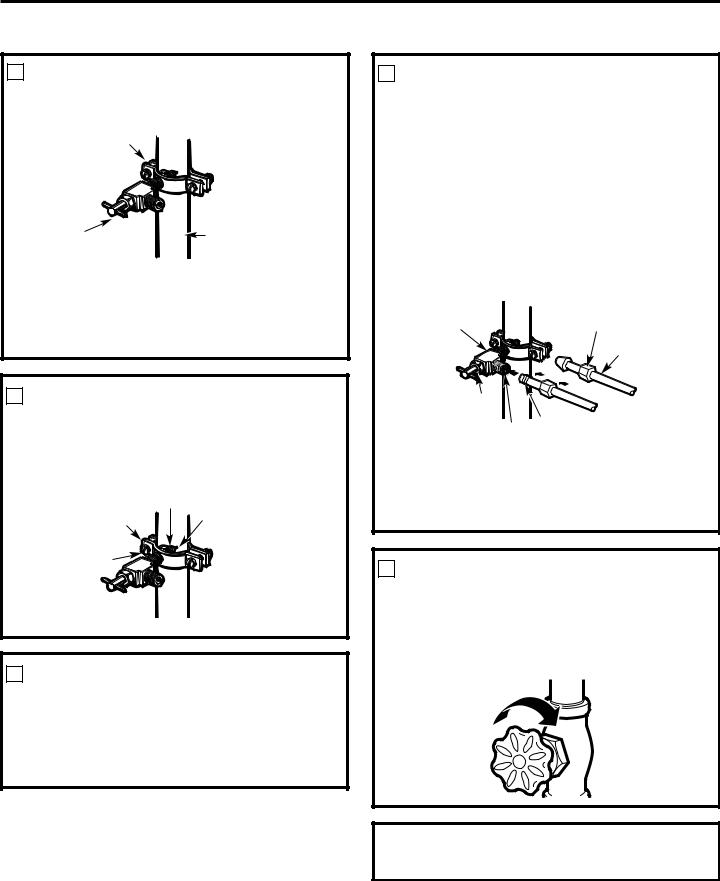
Installation Instructions
INSTALLING THE WATER LINE (CONT.)
4 FASTEN THE SHUTOFF VALVE
Fasten the shutoff valve to the cold water pipe with the pipe clamp.
Pipe Clamp
Saddle-Type |
Vertical Cold Water Pipe |
Shutoff Valve |
|
NOTE: Commonwealth of Massachusetts Plumbing Codes 248CMR shall be adhered to. Saddle valves are illegal and use is not permitted in Massachusetts. Consult with your licensed plumber.
5 TIGHTEN THE PIPE CLAMP
Tighten the clamp screws until the sealing washer begins to swell.
NOTE: Do not overtighten or you may crush the tubing.
|
Washer |
Pipe Clamp |
Inlet End |
|
|
Clamp |
|
Screw |
|
6 ROUTE THE TUBING
Route the tubing between the cold water line and the refrigerator.
Route the tubing through a hole drilled in the wall or floor (behind the refrigerator or adjacent base cabinet) as close to the wall as possible.
7 CONNECT THE TUBING TO THE VALVE
Place the compression nut and ferrule (sleeve) for copper tubing onto the end of the tubing and connect it to the shutoff valve.
Make sure the tubing is fully inserted into
the valve. Tighten the compression nut securely.
For plastic tubing from a GE SmartConnect™ Refrigerator Tubing kit, insert the molded end of the tubing into the shutoff valve and tighten compression nut until it is hand tight, then tighten one additional turn with a wrench. Overtightening may cause leaks.
Saddle-Type |
Compression Nut |
Shutoff Valve |
|
|
SmartConnect™ |
|
Tubing |
Packing Nut |
|
Ferrule (sleeve)
Outlet Valve
NOTE: Commonwealth of Massachusetts Plumbing Codes 248CMR shall be adhered to. Saddle valves are illegal and use is not permitted in Massachusetts. Consult with your licensed plumber.
8 FLUSH OUT THE TUBING
Turn the main water supply on and flush out the tubing until the water is clear.
Shut the water off at the water valve after about one quart (1 liter) of water has been flushed through the tubing.
To complete the installation of the refrigerator, go back to Step 1 in Installing the Refrigerator.
26
Downloaded from www.Manualslib.com manuals search engine
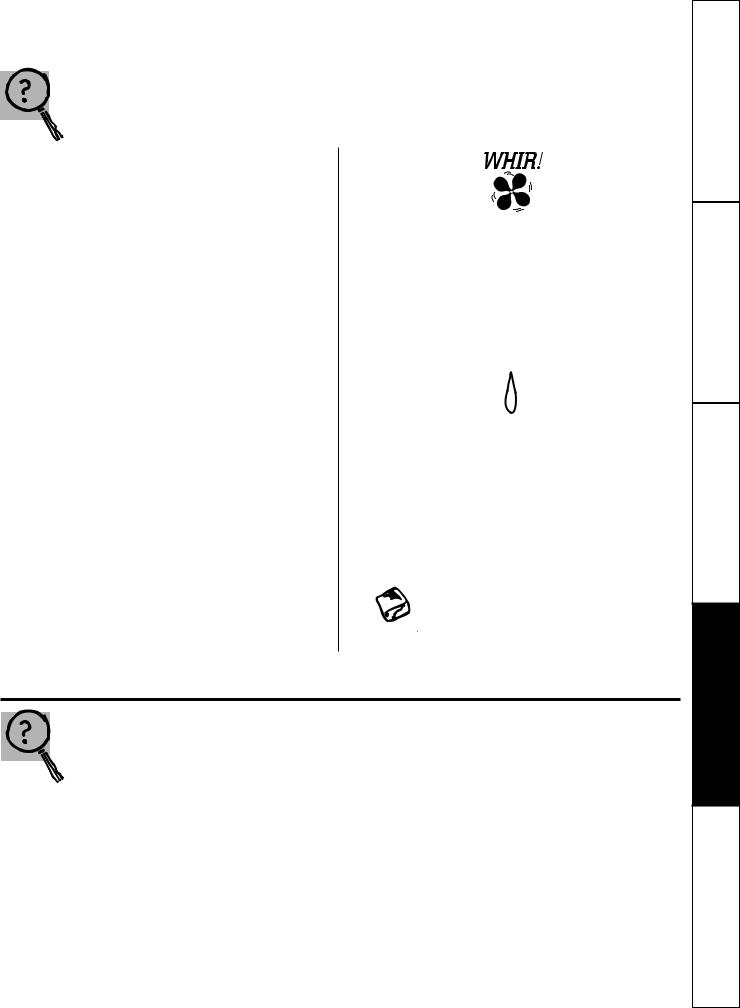
Normal operating sounds. |
ge.com |
Newer refrigerators sound different from older refrigerators.
Modern refrigerators have more features and use newer technology.
Do you hear what I hear? These sounds are normal.
|
|
|
HUMMM... |
|
|
|
|
|
|
WHOOSH... |
|
|
|
|
|
|
|
|
|
|
|
|
|
|
|
|
|
|
|
■ The new high efficiency compressor may run faster and longer |
|
||||
than your old refrigerator and you may hear a high-pitched hum |
■ You may hear the fans spinning at high speeds. This happens |
||||
or pulsating sound while it is operating. |
when the refrigerator is first plugged in, when the doors are |
||||
|
|
|
|
|
|
■ You may hear a whooshing sound when the doors close. |
opened frequently or when a large amount of food is added |
||||
This is due to pressure equalizing within the refrigerator. |
to the refrigerator or freezer compartments. The fans are |
||||
|
|
|
|
|
helping to maintain the correct temperatures. |
|
|
|
|
|
■ The fans change speeds in order to provide optimal cooling |
|
|
|
|
|
and energy savings. |
|
|
|
|
||
|
|
CLICKS, POPS, |
WATER SOUNDS |
||
CRACKS and SNAPS |
|
||||
■You may hear cracking or popping sounds when the refrigerator is first plugged in. This happens as the refrigerator cools
|
to the correct temperature. |
■ |
The flow of refrigerant through the freezer cooling coils may |
|||
|
|
make a gurgling noise like boiling water. |
||||
■ |
The freezer control will click when starting or stopping |
|
||||
■ |
Water dropping on the defrost heater can cause a sizzling, |
|||||
|
the compressor. |
|||||
|
|
popping or buzzing sound during the defrost cycle. |
||||
■ |
Expansion and contraction of cooling coils during |
|
||||
■ |
A water dripping noise may occur during the defrost cycle as ice |
|||||
|
and after defrost can cause a cracking or popping sound. |
|||||
|
|
melts from the evaporator and flows into the drain pan. |
||||
■ |
On models with an icemaker, after an icemaking cycle, |
|
||||
■ |
Closing the door may cause a gurgling sound due to pressure |
|||||
|
you may hear the ice cubes dropping into the ice bucket. |
|||||
|
|
equalization. |
||||
■ |
On models with a dispenser, during water dispense, you |
|
||||
|
|
|
|
|||
|
may hear the water lines move at initial dispense and after |
|
|
|
|
|
|
|
|
For additional information on normal |
|
||
|
dispenser button is released. |
|
|
|
||
|
|
|
icemaker operating sounds, see the |
|
||
|
|
|
|
|
||
|
|
|
|
About the automatic icemaker section. |
|
|
|
|
|
|
|
|
|
Before you call for service…
Troubleshooting Tips
Save time and money! Review the charts on the following pages first and you may not need to call for service.
Problem |
|
Possible Causes |
What To Do |
|
|
|
|
Refrigerator does not |
|
Refrigerator in defrost cycle. |
• Wait about 30 minutes for defrost cycle to end. |
operate |
|
|
|
|
|
|
|
|
|
Refrigerator is unplugged. |
• Push the plug completely into the outlet. |
|
|
|
|
|
|
The fuse is blown/circuit |
• Replace fuse or reset the breaker. |
|
|
breaker is tripped. |
|
|
|
|
|
Vibration or rattling |
|
Leveling legs need adjusting. |
• See Level the Refrigerator. |
(slight vibration |
|
|
|
is normal) |
|
|
|
27
Instructions Operating Instructions Safety
Instructions |
Installation |
Support Consumer Tips Troubleshooting
Downloaded from www.Manualslib.com manuals search engine

Operating Instructions Safety Instructions
Installation |
Instructions |
Consumer Support Troubleshooting Tips
Before you call for service…
Troubleshooting Tips
Problem |
Possible Causes |
What To Do |
|
|
|
Motor operates for long periods or cycles on and off frequently. (Modern refrigerators with more storage space and a larger freezer require more operating time. They start and stop often to maintain even
Normal when refrigerator |
• Wait 24 hours for the refrigerator to completely |
is first plugged in. |
cool down. |
|
|
Often occurs when large |
• This is normal. |
amounts of food are |
|
placed in refrigerator. |
|
|
|
Door left open. |
• Check to see if package is holding door open. |
|
|
Hot weather or frequent |
• This is normal. |
door openings. |
|
|
|
Temperature control |
• See About the controls. |
set at the coldest setting. |
|
Refrigerator or freezer |
Temperature controls not set |
• See About the controls. |
compartment too warm |
cold enough. |
|
|
|
|
|
Warm weather or frequent |
• Set the temperature control one step colder. |
|
door openings. |
See About the controls. |
|
|
|
|
Door left open. |
• Check to see if package is holding door open. |
|
|
|
Frost or ice crystals |
Door left open. |
• Check to see if package is holding door open. |
on frozen food |
|
|
Door openings too frequent |
|
|
(frost within package |
|
|
or too long. |
|
|
is normal) |
|
|
|
|
|
|
|
|
Frequent “buzzing” |
Ice Off feature is turned |
• Press and release the Ice Off/Lock pad on the control |
sound |
off, but the water supply |
panel to turn on the Ice Off feature, and then the |
|
to the refrigerator has not |
icon will be displayed. Keeping the Ice Off feature |
|
been connected. |
on will damage the water valve. |
|
|
|
Small or hollow cubes |
Water filter clogged. |
• Replace filter cartridge with new cartridge or with plug. |
|
|
|
Automatic icemaker |
Ice Off feature is turned on. |
• Press and release the Ice Off/Lock pad on the control |
does not work |
|
panel to turn off the Ice Off feature, and then the |
|
|
icon will disappear. |
|
|
|
|
Water supply turned off or |
• See Installing the water line. |
|
not connected. |
|
|
|
|
|
Freezer compartment |
• Wait 24 hours for the refrigerator to completely |
|
too warm. |
cool down. |
|
|
|
|
Piled up cubes in the storage |
• Level cubes by hand. |
|
bin cause the icemaker |
|
|
to shut off. |
|
|
|
|
|
Ice cubes stuck in icemaker. |
• Turn off the icemaker, remove cubes and turn |
|
|
the icemaker back on. |
28
Downloaded from www.Manualslib.com manuals search engine

ge.com
Problem |
|
Possible Causes |
What To Do |
|
|
|
|
Ice cubes have |
|
Food transmitting odor/taste |
• Wrap foods well. |
odor/taste |
|
to ice cubes. |
|
|
|
|
|
|
|
Interior of refrigerator |
• See Care and cleaning. |
|
|
needs cleaning. |
• Keep an open box of baking soda in the refrigerator; |
|
|
|
|
|
|
|
replace every three months. |
|
|
|
|
Slow ice cube freezing |
|
Door left open. |
• Check to see if package is holding door open. |
|
|
|
|
|
|
Freezer control not set |
• See About the controls. |
|
|
cold enough. |
|
|
|
|
|
Refrigerator has odor |
|
Foods transmitting |
• Foods with strong odors should be tightly wrapped. |
|
|
odor to refrigerator. |
• Keep an open box of baking soda in the refrigerator; |
|
|
|
|
|
|
|
replace every three months. |
|
|
|
|
|
|
Interior needs cleaning. |
• See Care and cleaning. |
|
|
|
|
Moisture forms on |
|
Not unusual during |
• Wipe surface dry and reset the refrigerator control |
outside of refrigerator |
|
periods of high humidity. |
one setting colder. |
|
|
|
• Turn off Energy Saver mode. |
|
|
|
|
Moisture collects inside |
|
Too frequent or too |
|
(in humid weather, air |
|
long door openings. |
|
carries moisture into |
|
|
|
refrigerator when doors |
|
|
|
are opened) |
|
|
|
|
|
|
|
Refrigerator or freezer |
|
No power at outlet. |
• Replace fuse or reset the breaker. |
compartment light does |
|
|
|
|
Light bulb burned out or loose. |
• See Replacing the light bulbs. |
|
not work |
|
||
|
|
|
|
|
|
|
|
Door/drawer does not |
|
Leveling legs need adjusting. |
• See Installing the Refrigerator. |
close by itself |
|
|
|
|
|
|
|
Hot air from bottom |
|
Normal air flow cooling |
|
of refrigerator |
|
motor. In the refrigeration |
|
|
|
process, it is normal that |
|
|
|
heat be expelled in the |
|
|
|
area under the refrigerator. |
|
|
|
Some floor coverings will |
|
|
|
discolor at these normal |
|
|
|
and safe temperatures. |
|
|
|
|
|
Food freezing in |
|
Food too close to the air vent |
• Move the food away from the air vent. |
the refrigerator |
|
at the back of the refrigerator. |
|
|
|
|
|
|
|
Refrigerator control is set |
• Move the refrigerator control to a warmer |
|
|
too cold. |
temperature setting one increment at a time. |
|
|
|
|
29
Instructions Operating Instructions Safety
Instructions |
Installation |
Support Consumer Tips Troubleshooting
Downloaded from www.Manualslib.com manuals search engine
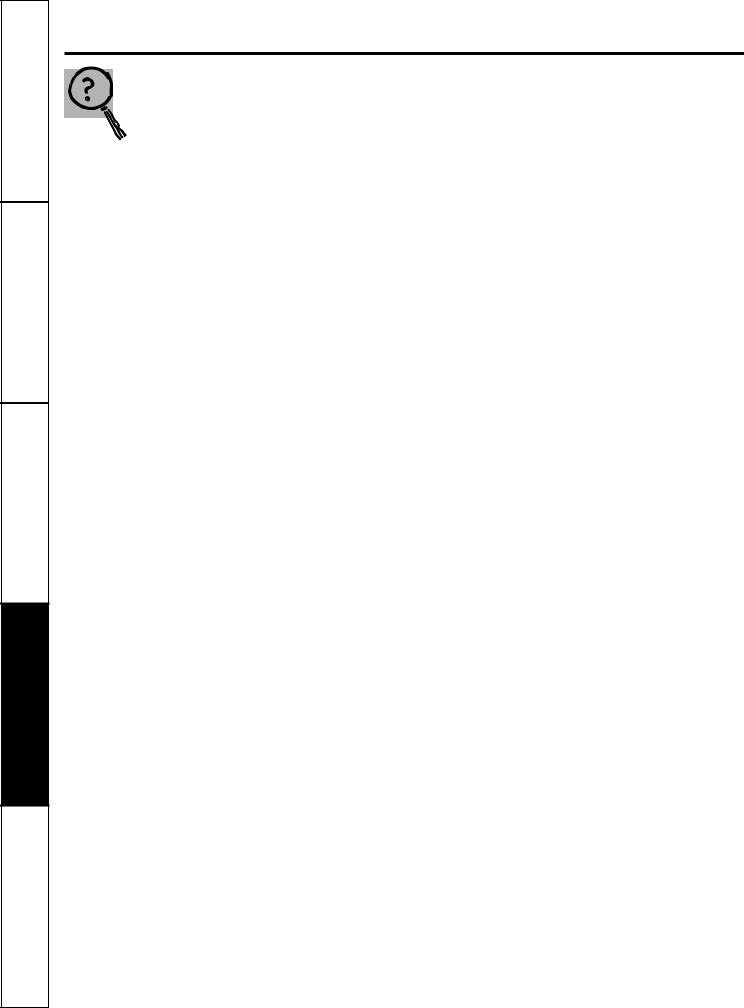
Operating Instructions Safety Instructions
Installation |
Instructions |
Consumer Support Troubleshooting Tips
Before you call for service…
Troubleshooting Tips
Problem |
|
Possible Causes |
What To Do |
|
|
|
|
Water has poor |
|
Water dispenser has not been |
• Dispense water until all water in system is replenished. |
taste/odor |
|
used for a long time. |
|
|
|
|
|
Water in first glass |
|
Normal when refrigerator |
• Wait 24 hours for the refrigerator to completely |
is warm |
|
is first installed. |
cool down. |
|
|
|
|
|
|
Water dispenser has not been |
• Dispense water until all water is system is replenished. |
|
|
used for a long time. |
|
|
|
|
|
|
|
Water system has been drained. |
• Allow several hours for replenished supply to chill. |
|
|
|
|
Water dispenser |
|
Water supply line turned off |
• See Installing the water line. |
does not work |
|
or not connected. |
|
|
|
|
|
|
|
Water filter clogged. |
• Replace filter cartridge or remove filter and install plug. |
|
|
|
|
|
|
Air may be trapped in |
• Press the dispenser arm for at least 2 minutes. |
|
|
the water system. |
|
|
|
|
|
|
|
Water in reservoir is frozen |
• Set the refrigerator control to a warmer setting and wait |
|
|
because the controls are set |
24 hours. If water does not dispense after 24 hours, call |
|
|
too cold. |
for service. |
|
|
|
|
Flow of water to |
|
Water filter clogged. |
• Replace filter cartridge or remove filter and install plug. |
dispenser or icemaker |
|
|
|
is slow |
|
|
|
|
|
|
|
Water spurting from |
|
Newly installed filter cartridge. |
• Run water from the dispenser for 3 minutes |
dispenser |
|
|
(about 11⁄2 gallons). |
|
|
|
|
No water or ice cube |
|
Supply line or shutoff valve |
• Call a plumber. |
production |
|
is clogged. |
|
|
|
|
|
|
|
Water filter clogged. |
• Replace filter cartridge or remove filter and install plug. |
|
|
|
|
|
|
Filter cartridge not |
• Remove and reinstall filter cartridge, being certain that |
|
|
properly installed. |
it locks into place. The blade on the end of the cartridge |
|
|
|
should be positioned vertically. |
|
|
|
|
Water is leaking from |
|
Glass not being held under |
• Hold the glass underneath the dispenser for 2–3 seconds |
dispenser |
|
the dispenser long enough |
after releasing the dispenser button. Water may continue |
|
|
after button is released. |
to dispense after the button is released. |
|
|
|
|
|
|
Air may be present in the |
• Dispense water for at least 2 minutes to remove air |
|
|
water line system, causing |
from system. |
|
|
water to drip after being |
|
|
|
dispensed. |
|
|
|
|
|
Handle is loose / handle |
|
Handle needs adjusting. |
• See Attach the Fresh Food handle and Attach |
has a gap |
|
|
the Freezer handle sections for detailed instructions. |
|
|
|
|
Refrigerator beeping |
|
This is the door alarm. |
• Close door. |
|
|
|
|
30
Downloaded from www.Manualslib.com manuals search engine
